#Ray Barbier
Explore tagged Tumblr posts
Text










LADIES SHOULD LISTEN (1934) dir. Frank Tuttle
#ladies should listen#cary grant#frances drake#edward everett horton#nydia westman#rafael corio#rosita moreno#george barbier#charles ray#charles arnt#classicfilmblr#classicfilmsource#old hollywood#classicfilmedit#vintagedit#moviegifs#filmedit#filmgifs#movieedits#oldhollywoodedit#cinemaspast#blackandwhiteedit#z*
106 notes
·
View notes
Text
Prelims
Poll A5

9 contestants, 4 spots for the tournament
#tournament polls#godsnames tournament#prelims#dianamon#digimon#alpha flight#x men comics#x men#ffxiv gaia#ffxiv#final fantasy xiv#ff14#dio brando#jjba dio#jjba#jojo's bizarre adventure#rockman.exe#megaman#megaman iris#tales of the rays#the witcher#witcher#cirilla fiona elen riannon#cirilla of cintra#wolf 359#honkai impact 3rd#kiana kaslana#hi3rd#jojos bizarre adventure
30 notes
·
View notes
Text
POTO Korea Christine 손지수[Sohn Ji-soo]'s essay, "크리스틴을 만나다(Meeting Christine)". (+ Her '시어터플러스(THEATRE+)' interview.)
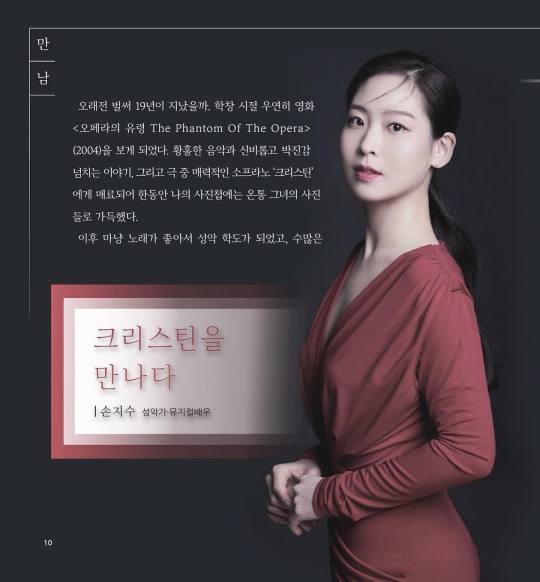
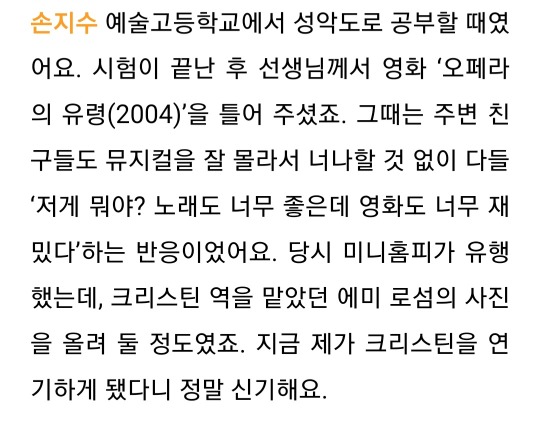
It seems like 19 years have passed already. When I was a student, I happened to see the movie <The Phantom of the Opera> (2004) (at school. *손지수 graduated 선화 Arts Middle School Department of Vocal Music and 선화 " High " ). Fascinated by the enchanting music, mysterious and thrilling stories, and the charming soprano "Christine" in the play, my photo album was filled with her pictures for a while. I even put a picture of Emmy Rossum on my mini homepage.
Living in a lot of classical music, my dream has always been to be a soprano. "Someday, I will sing on stage like Christine."
After graduating from vocal music and making my debut in Milano, I became a soprano of my dreams.
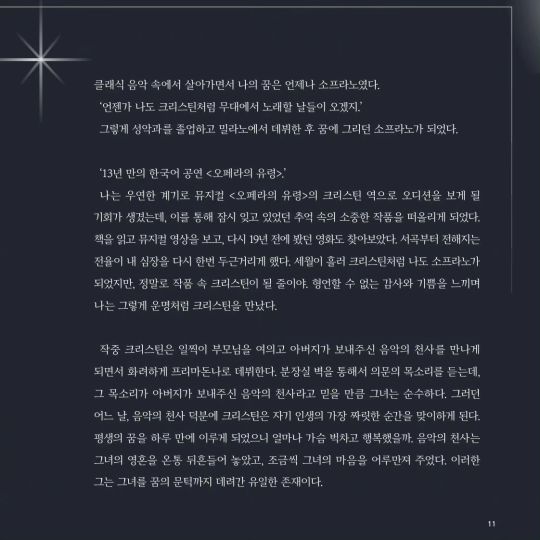
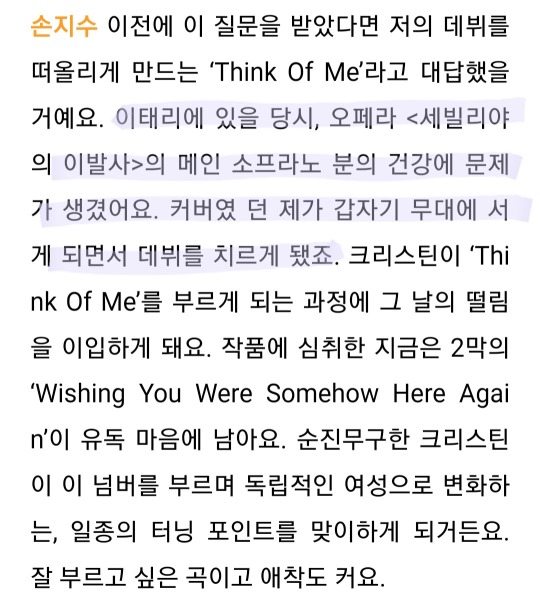
* 손지수 graduated with top honors from 서울(Seoul) National University Department of Vocal Music. After that, she graduated from the 'Conservatorio di Musicica Giuseppe Verdi di Milano'. In 2014, she made her debut in Milano as Rosina, the heroine of the opera 'Il barbiere di Siviglia(The Barber of Seville)'. According to her, a soprano who was supposed to play Rosina was sick. So 손지수, who was an understudy, suddenly made her debut as the heroine Rosina. She said that the trembling emotions of the day were imbued when she sang 'Think Of Me' as Christine.
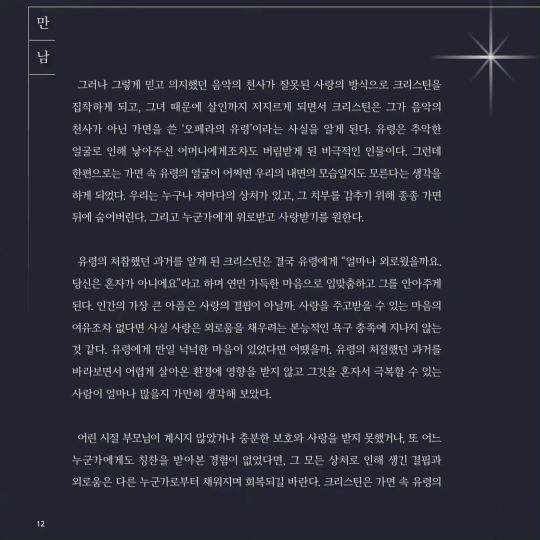
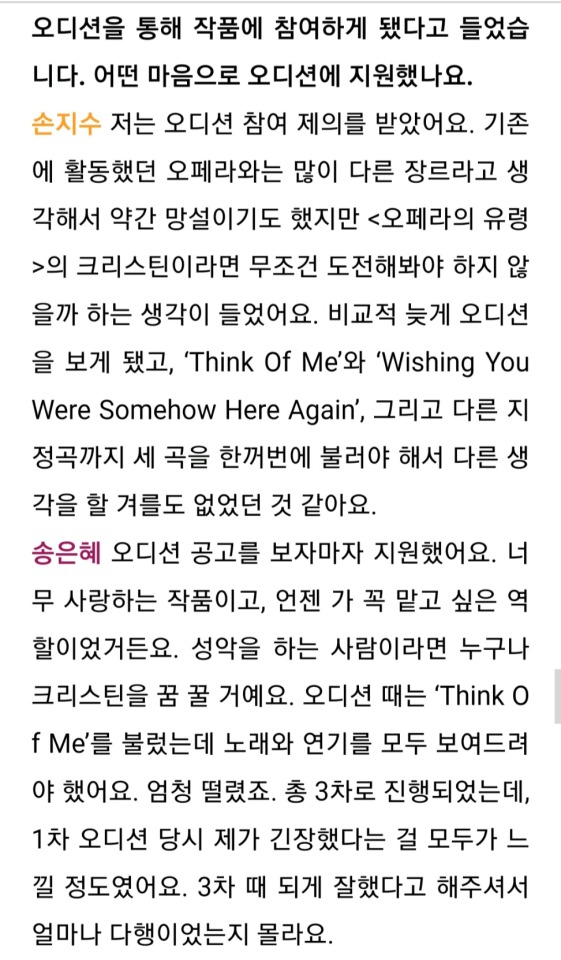
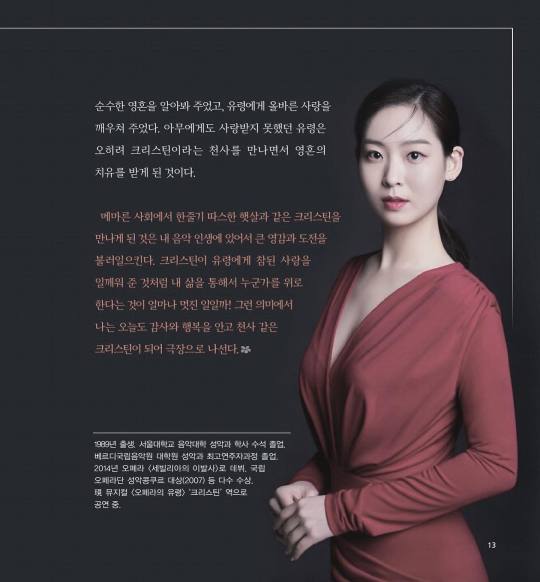
"<The Phantom of the Opera>, which will be performed in Korean again after 13 years."
I had a chance to audition for a call(The other Christine, 송은혜[Song Eun-hye], who became a phan after watching 최현주's performance in 2009, passed a general audition and became a Christine. (송은혜 is also a fan of Sierra Boggess.) 손지수 was selected as Christine among the call audition participants. The reason why the call audition was held was because they couldn't find a satisfied applicant other than 송은혜 in the general audition. *송은혜 majored in opera, but worked as a popera singer/an ensemble in the musical Elisabeth. *손지수 is an opera singer and made her musical debut with the Phantom of the Opera.) as Christine in the musical <The Phantom of the Opera>, which reminded me of a precious (art)work in my memories that I had forgotten for a while.
I read a book, watched a musical video, and looked for the movie that I watched 19 years ago. The thrill from the overture made my heart pound once again. Over the years, I became a soprano like Christine, but I never thought I would be Christine in the work. Feeling indescribable gratitude and joy, I met Christine like fate.
...
I came to think that the face of the Phantom in the mask might be our inner self. Everyone has their own wounds, and we often hide behind masks to hide their disgrace. And we want to be comforted and loved by someone.
...
Looking at the Phantom's desperate past, I thought about how many people could overcome it alone without being affected by the difficult environment.
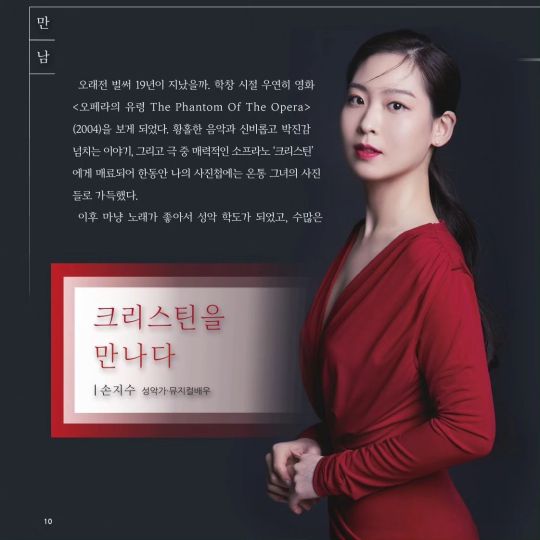
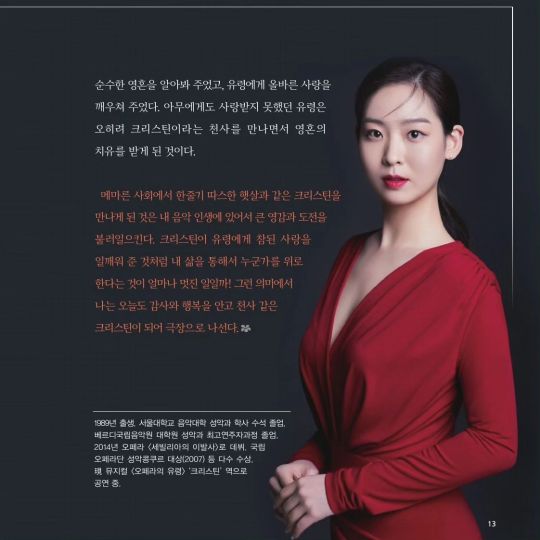
Christine recognized the pure soul of the Phantom in the mask, and enlightened the Phantom with the right love. The Phantom, who was not loved by anyone, received spiritual healing when he met an angel named Christine.
Meeting Christine, who is like a ray of warm sunshine in a dry society, raises great inspiration and challenges in my music life. How wonderful it would be to console someone through my life like Christine told the Phantom true love! In that sense, I am going to the theater as an angelic Christine with gratitude and happiness again today.
#the phantom of the opera#poto korea#오페라의 유령#손지수#poto 3rd korea#오페라의 유령 삼연#poto essay#poto 2004#the phantom of the opera 2004#emmy rossum#송은혜
19 notes
·
View notes
Text
LÉGENDES DU JAZZ
ART BLAKEY, LE MESSAGER DU JAZZ “Blakey proved to be the most important mentor in jazz, introducing one great jazz talent after another by way of his Jazz Messengers—players who would go on to enjoy giant careers themselves.’’
- Peter Erskine
Né le 11 octobre 1919 à Pittsburgh, en Pennsylvanie, Arthur William Blakey était probablement le fils d’une mère célibataire connue sous le nom de Marie Roddicker ou Roddericker qui est décédée environ six mois après sa naissance. Le père biologique de Blakey, Bertram Thomas Blakey, était un barbier originaire d’Ozark en Alabama, mais sa famille s��était installée à Pittsburgh entre 1900 et 1910. Le père de Blakey aurait abandonné sa mère et son fils peu après sa naissance.
L’oncle de Blakey, Rubi Blakey, était un populaire chanteur de Pittsburgh qui était également directeur de chorale et un professeur qui avait fréquenté l’Université de Fisk, à Nashville. JEUNESSE ET ÉDUCATION Après la mort de sa mère, Blakey avait été élevé avec ses frères et soeurs par des amis ou des parents de la famille qui avaient un peu servi de famille de substitution. C’est sa cousine Sarah Oliver Parran et sa famille élargie qui auraient élevé Blakey jusqu’à ce qu’il commence à travailler dans une des usines sidérurgiques de l’endroit. Les témoignages ne s’entendent pas sur la durée du séjour de Blakey chez les Parran, même s’il est clair qu’il y a passé une bonne partie de son enfance. Même s’il était largement autodidacte, Blakey semble avoir reçu quelques leçons de piano à l’école. Selon certaines sources, Blakey aurait abandonné l’école après sa septième année pour travailler dans une usine sidérurgique et jouer de la musique le soir. C’est en jouant du piano que Blakey avait appris à diriger ses propres groupes. On raconte même qu’il dirigeait son propre groupe de danse à l’âge de quatorze ans. DÉBUTS DE CARRIÈRE C’est un peu par accident que Blakey avait troqué le piano pour la batterie au début des années 1930. On raconte qu’un propriétaire de club avait obligé Blakey à passer à la batterie afin de permettre au pianiste Erroll Garner de prendre sa place au piano. Blakey expliquait: “So I just went up there and played the show [on drums],”How, I’ll never know, but I made it.”
C’est donc un peu ‘’sur le tas’’ que Blakey avait appris à jouer de la batterie. Il précisait:
“I used to play every night. It didn’t matter how much money I was making, I just had to play every night. When we’d get through playing at night, it was daybreak. Then we’d play the breakfast show. After that we’d have a jam session, which would go on until like 2:00 in the afternoon. So maybe by 3:00 I’d get to bed, and I’d be back in the club again at 8:30. So I never stopped. I was playing all the time, so I didn’t have to worry about practicing. But when I did, I’d usually just practice on a pillow. I’d never practice on a pad because a pillow would make me pick up my sticks instead of depending on the rebound of the pad.”
Blakey avait aussi reçu des conseils précieux d’autres batteurs de Pittsburgh. Il racontait: “There was Klook [Kenny Clarke], there was a drummer named Jimmy Peck, and then there was a guy named Sammy Carter. But the guy I learned the most from in Pittsburgh was a guy named Honeyboy. That’s the cat who taught me how to play shows.” Blakey avait aussi obtenu des conseils de Chick Webb.
À l’époque, Blakey avait adopté le style agressif de batteurs de swing comme Chick Webb, Big Sid Catlett, Kaiser Marshall et Ray Bauduc. Il avait aussi été influencé par Gene Krupa et Kenny Clarke. Le rythme endiablé de la musique africaine avait également influencé Blakey, plus particulièrement après son séjour en Afrique en 1947. Même s’il avait adopté certaines techniques de percussion africaines à la suite de son séjour, Blakey ne ressentait aucune filiation particulière avec l’Afrique, car il se considérait d’abord comme un citoyen du monde. Il expliquait: “Since so many of the great jazz musicians are black, they try to connect us to Africa. But I’m an American black man. We ain’t got no connection to Africa. I imagine some of my people come from Africa, but there are some Irish people in there, too. I’m a human being and it don’t make no difference where I come from.’’
Lorsqu’on reprochait à Blakey de jouer de façon un peu trop énergique, il répondait:
“I just wanted to hear something different—to experiment. I always liked to innovate with different sounds on the drums when I started to play, because I came out of that era when the drummer played for effects. I had to learn to play a show in almost a standing position. I had to keep the bass drum going, grab this and blow that, and do a roll. But that was fantastic because it helped me get where I wanted to go and helped me find out what it was I wanted to do.’’
De 1939 à 1944, Blakey avait accompagné sa compatriote de Pittsburgh, la pianiste Mary Lou Williams, dans un engagement au club Kelly’s Stables de New York. Il avait aussi fait une tournée avec l’orchestre de Fletcher Henderson. Même si la chronologie exacte des événements n’est pas toujours claire, la plupart des sources s’accordent pour affirmer que Blakey avait joué dans le big band de Williams en 1942 avant de se joindre à l’orchestre d’Henderson un an plus tard.
Pendant qu’il jouait avec l’orchestre d’Henderson, Blakey avait été attaqué sans la moindre provocation par un policier de Georgie. La violence de cette agression était telle que Blakey avait dû se faire installer une plaque d’acier sous le crâne. À la suite de cette intervention, Blakey avait été déclaré inapte à prendre part à la Seconde Guerre mondiale. Après cette altercation, Blakey avait dirigé son propre groupe au Tic Toc Club de Boston durant une courte période. De 1944 à 1947, Blakey avait travaillé avec le big band de Billy Eckstine. C’est grâce à son association avec cette formation que Blakey avait commencé à s’associer au mouvement bebop et à ses principaux chefs de file: Miles Davis, Dexter Gordon, Fats Navarro, Dizzy Gillespie, Charlie Parker, Billie Holiday, Sarah Vaughan, etc.
En 1947, Blakey avaiit participé à plusieurs enregistrements avec le pianiste Thelonious Monk. C’est lors de ces sessions qu’avaient été enregistrées les premières versions de certains classiques de Monk comme ‘’Round Midnight’’, ‘’Well, You Needn’t’’ et ‘’Ruby My Dear.’’ Il s’agissait des premières sessions d’enregistrement de Monk comme leader.
Monk avait pris Blakey sous son aile à son arrivée à New York et l’avait aidé à faire sa place dans le milieu tumultueux des clubs new-yorkais. Comme Blakey l’avait expliqué dans une entrevue accordée au magazine Down Beat, ‘’He was my best friend.... If it hadn't been for him, I'm not so sure I would have been me. I learned so much playing with him, being with him." Blakey avait également enregistré en 1971 deux albums en trio avec Monk intitulés ‘’Something in Blue’’ et ‘’The Man I Love.’’ Ces deux sessions d’enregistrement avaient d’ailleurs été les deux dernières de la carrière de Monk. En 1947, après la dissolution du big band d’Eckstine, Blakey avait séjourné en Afrique de l’ouest durant un an afin d’explorer la culture et la religion de l’Islam. À l’époque, plusieurs Afro-Américains étaient influencés par le missionnaire musulman Kahili Ahmed Nasir. C’est à la suite de ce voyage que Blakey s’était converti à l’Islam et avait adopté le nom de Abdullag Ibu Buhaina. Il avait même dirigé un big band appelé les 17 Messengers dont tous les membres portaient le turban ! Plutôt précaire financièrement, le groupe avaient été démantelé quelque temps plus tard.
Blakey avait cependant cessé d’être un musulman pratiquant dans les années 1950. Il avait continué de jouer sous le nom d’Art Blakey durant le reste de sa carrière.
Comme Blakey le reconnaissait lui-même, "In 1947, after the Eckstine band broke up, we—took a trip to Africa. I was supposed to stay there three months and I stayed two years because I wanted to live among the people and find out just how they lived and—about the drums especially." Dans une entrevue accordée en 1979 au magazine Down Beat, Blakey avait tenu à préciser: "I didn't go to Africa to study drums – somebody wrote that – I went to Africa because there wasn't anything else for me to do. I couldn't get any gigs, and I had to work my way over on a boat. I went over there to study religion and philosophy. I didn't bother with the drums, I wasn't after that. I went over there to see what I could do about religion. When I was growing up I had no choice, I was just thrown into a church and told this is what I was going to be. I didn't want to be their Christian. I didn't like it. You could study politics in this country, but I didn't have access to the religions of the world. That's why I went to Africa. When I got back people got the idea I went there to learn about music."
Au début des années 1950, Blakey avait accompagné des musiciens de jazz comme Miles Davis, Charlie Parker, Dizzy Gillespie et Thelonious Monk, dont il aurait été le batteur de prédilection. De 1951 à 1953, Blakey avait fait une tournée avec le clarinettiste Buddy DeFranco. Le groupe comprenait aussi le pianiste Kenny Drew.
LA FONDATION DES JAZZ MESSENGERS
Le 17 décembre 1947, Blakey avait dirigé sa première session pour Blue Note, dans le cadre d’un groupe connu sous l’appellation d’’’Art Blakey’s Messengers.’’ Publiés d’abord sous forme de 78 tours, les premiers enregistrements du groupe contenaient deux pièces qui avaient plus tard été rééditées sur une compilation intitulée ‘’New Sounds.’’ À l’époque, le groupe comprenait huit musiciens parmi lesquels on remarquait Kenny Dorham, Musa Shihab, Musa Kaleem et Walter Bishop Jr.
Le nom de ‘’Messengers’’ avait éventuellement fini par s’imposer dans le cadre d’un groupe co-dirigé par Blakey et le pianiste Horace Silver, même si le nom n’avait pas été utilisé dans les premiers albums de la formation.
Le nom de Jazz Messengers avait été utilisé pour la première fois sur une session d’enregistrement de 1954 officiellement dirigée par Silver et mettant en vedette Blakey, Hank Mobley, Kenny Dorham et Doug Watkins. Le même quintet avait enregistré l’album ‘’The Jazz Messengers at the Cafe Bohemia’’ l’année suivante. Après que Donald Byrd ait remplacé Dorham à la trompette, le groupe avait enregistré un album simplement intitulé ‘’The Jazz Messengers’’ pour les disques Columbia en 1956. Blakey avait repris le nom du groupe lorsque Silver avait quitté la formation après sa première année d’existence (Silver avait apporté Mobley et Watkins avec lui pour fonder son propre quintet). Éventuellement, le nom de Blakey avait été ajouté au nom du groupe, qui se fit désormais connaître sous le titre de ‘’Art Blakey and the Jazz Messengers.’’ Blakey avait dirigé le groupe jusqu’à sa mort.
Avec le temps, les Jazz Messengers étaient devenus une sorte d’archétype des groupes de hard bop des années 1950. Le groupe jouait une version agressive de bop qui était profondément enracinée dans le blues. À la fin des années 1950, les saxophonistes Johnny Griffin et Benny Golson s’étaient brièvement joints au groupe. Golson, comme directeur musical de la formation, avait composé plusieurs classiques du jazz qui avaient été intégrés au répertoire du groupe, comme ‘’I Remember Clifford’’ (un hommage à Clifford Brown), ‘’Along Came Betty’’ et ‘’Blues March’’, et qui avaient souvent été réinterprétés par les éditions ultérieures des Jazz Messengers. Golson avait également composé les pièces ‘’Whisper Not’’ et ‘’Are You Real.’’
UNE PÉPINIÈRE DE NOUVEAUX TALENTS
De 1959 à 1961, les Jazz Messengers étaient composés de Wayne Shorter au saxophone ténor, de Lee Morgan à la trompette, de Bobby Timmons au piano et de Jymie Merritt à la contrebasse. Au cours de cette période, le groupe avait enregistré plusieurs albums pour Blue Note, dont ‘’The Big Beat’’ et ‘’A Night in Tunisia.’’ De 1961 à 1964, le groupe s’était transformé en sextet avec l’ajout du joueur de trombone Curtis Fuller. Quant à Morgan, Timmons et Merritt, ils avaient été remplacés par Freddie Hubbard, Cedar Walton et Reggie Workman.
Le groupe, qui était devenu une véritable pépinière pour les nouveaux talents, avait enregistré les albums ‘’Buhaina’s Delight’’, ‘’Caravan’’ et ‘’Free for All.’’ Même si des vétérans du jazz ressurgissaient périodiquement dans la formation, chaque nouvelle édition des Messengers comprenait un alignement de ‘’jeunes loups.’’ Un séjour chez les Messengers était souvent considéré comme un rite de passage obligé pour les jeunes recrues.
Dans les années 1960, les Jazz Messengers étaient devenus un incontournable du circuit des clubs de jazz. Le groupe avait aussi fait des tournées en Europe et dans le nord de l’Afrique. En 1960, le groupe était devenu la première formation de jazz américain à se produire au Japon. En tout et pour tout, le groupe s’était rendu au Japon à 47 reprises au cours de son histoire.
Plusieurs recrues des Messengers étaient devenus des vedettes du jazz après leur passage dans le groupe: Lee Morgan, Clifford Brown, Benny Golson, Wayne Shorter, Johnny Griffin, Freddie Hubbard, Bobby Timmons, Curtis Fuller, Hank Mobley, Ira Sullivan, Donald Byrd, Kenny Dorham, Wallace Roney, Robin Eubanks, Cedar Walton, Curtis Fuller, Slide Hampton, Jackie McLean, Chuck Mangione, Keith Jarrett, Joanne Brackeen, James Williams, Woody Shaw, Wynton Marsalis, Branford Marsalis, Gary Bartz, Jaki Byard, Lou Donaldson, Terence Blanchard, Donald Harrison, Bobby Watson, Mulgrew Miller et combien d’autres.
Blakey avait enregistré des dizaines d’albums avec les Messengers. Que le groupe ait survécu à autant de changements de personnel demeure tout un exploit. Quand on demandait à Blakey pourquoi il recourait à de jeunes pousses qui n’avaient pas encore fait leurs preuves plutôt que de miser sur la sécurité en faisant appel à des vedettes établies, il répondait simplement: "I'm gonna stay with the youngsters. When these get too old I'll get some younger ones. Keeps the mind active." Dans une entrevue accordée en 1984, Blakey avait donné une autre raison de sa persistance à engager de jeunes musiciens. Il expliquait:
‘’My current band is pretty good, but I’m going to switch up the guys pretty soon. There are so many young kids out there who need the opportunity. I don’t want nobody in my band too long, because when cats stay too long, they get complacent, get big heads, and then it’s time to get out, buddy, because there are no stars in this band: The band is the star. Besides, I like to hear different interpretations. About my favorite Jazz Messenger group was the one with Wayne [Shorter], Freddie [Hubbard], Curtis [Fuller], Jymie [Merritt], and Cedar [Walton]. Musicians like that don’t come along all the time, but if you keep combing the woods, one will turn up sooner or later. And when they get strong enough to be on their own, I let them know it—time to do your own thing. See, a lot of things that happen in my band I don’t agree with, but I want to give it a chance to develop because there are some heavy young people out there.’’
Même si la popularité des Messengers avait nettement décliné avec l’émergence du jazz-fusion dans les années 1970, Blakey avait continué de miser sur de jeunes recrues comme Terence Blanchard et Kenny Garrett. Partisan du jazz acoustique, Blakey avait toujours résisté avec tenacité à toute tentative visant à ‘’moderniser’’ le son du groupe. Il expliquait: ‘’Jazz is an art form, and you have to choose. The record company executives with an eye on trends said to me, ‘Well Blakey, if you update your music and change it, put a little rock in there, you’ll come along.’ I will not prostitute my art for that. It’s not worth it. Gain the world and lose your soul? It’s no good.”
En 1971-1972, Blakey avait quitté temporairement les Messengers pour partir en tournée avec les Giants of Jazz, un groupe tout-étoile composé de Dizzy Gillespie, Kai Winding, Sonny Stitt, Thelonious Monk et Al McKibbon. En 1974, il avait aussi participé à une légendaire bataille des batteurs avec Max Roach, Buddy Rich et Elvin Jones dans le cadre du Festival de jazz de Newport.
PROBLÈMES DE SANTÉ ET DÉCÈS
Blakey avait continué de jouer et de faire des tournées avec le groupe jusqu’à la fin des années 1980. Ralph Peterson Jr. s’était joint à la formation comme second batteur afin de suppléer à la santé défaillante de Blakey. Blakey avait joué avec tant de puissance et de furie au cours de sa carrière qu’il était pratiquement devenu sourd. Si Blakey avait pu poursuivre sa carrière, c’est qu’il jouait surtout par instinct en demeurant à l’écoute des vibrations qu’il ressentait autour de lui. Il précisait: “The only thing I can hear is music. I can hear vibrations. I take my hearing aid off when I’m on the bandstand, and I can hear better than the other musicians; I know when they’re out of tune.”
Blakey avait toujours refusé de porter des prothèses auditives sous prétexte que cela nuisait à son synchronisme.
Le saxophoniste ténor Javon Jackson, qui avait fait partie des dernières éditions des Messengers, avait prétendu que Blakey avait exagéré la diminution de ses facultés auditives. Il expliquait: "In my opinion, his deafness was a little exaggerated, and it was exaggerated by him. He didn't hear well out of one ear, but he could hear just fine out the other one. He could hear you just fine when you played something badly and he was quick to say 'Hey, you missed that there.' But anything like 'I don't think I'll be available for the next gig', he'd say 'Huh? I can't hear you.'" Un autre musicien de la dernière heure, le pianiste Geoffrey Keezer, avait affirmé que la surdité de Blakey était simulée. Il précisait: ‘'He was selectively deaf. He'd go deaf when you asked him about money, but if it was real quiet and you talked to him one-on-one, then he could hear you just fine.'"
Art Blakey a présenté son dernier concert en juillet 1990. Il est mort le 16 octobre au St. Vincent’s Hospital de Manhattan. Il était mort d’un cancer du poumon, cinq jours après son 71e anniversaire de naissance. Blakey était en tournée au Japon lorsqu’il avait dû revenir aux États-Unis précipitamment, car il croyait avoir contracté une pneumonie.
Blakey laissait dans le deuil six filles (Gwendolyn, Evelyn, Jackie, Sakeena, Kadijah et Akira) et trois garçons (Takashi, Gamal et Kenji).
Lors des funérailles de Blakey célébrées le 22 octobre 1990 à l’église Abyssinian Baptist, plusieurs anciens membres des Messengers s’étaient réunis afin d’interpréter quelques-uns des plus grands succès du groupe. Parmi ces musiciens, on remarquait Brian Lynch, Javon Jackson, Geoffrey Keezer, Wynton Marsalis, Terence Blanchard, Valery Ponomarev, Benny Golson, Donald Harrison, Essiet Okon Essiet et Kenny Washington. Au nombre des pièces interprétées, mentionnons ‘’Along Came Betty’’ de Benny Golson, ‘’Moanin’’’ de Bobby Timmons et ‘’One by One’’ de Wayne Shorter. Jackson, un membre des dernières éditions des Messengers, avait souligné à quel point ses expériences avec Blakey avaient changé sa vie. Il expliquait: "He taught me how to be a man. How to stand up and be accounted for". Jackie McLean, Ray Bryant, Dizzy Gillespie et Max Roach avaient aussi rendu hommage à Blakey lors des funérailles.
Blakey est considéré comme un des inventeurs du bebop avec Charlie Parker, Dizzy Gillespie, Charlie Christian, Thelonious Monk, Kenny Clarke et Max Roach. Rendant hommage à Blakey après sa mort, Roach avait déclaré:
‘’Art was an original… He's the only drummer whose time I recognize immediately. And his signature style was amazing; we used to call him 'Thunder.' When I first met him on 52d Street in 1944, he already had the polyrhythmic thing down. Art was perhaps the best at maintaining independence with all four limbs. He was doing it before anybody was."
Dans les notes accompagnant la série de Ken Burns sur le jazz, on pouvait lire: "Blakey is a major figure in modern jazz and an important stylist in drums. From his earliest recording sessions with Eckstine, and particularly in his historic sessions with Monk in 1947, he exudes power and originality, creating a dark cymbal sound punctuated by frequent loud snare and bass drum accents in triplets or cross-rhythms." Burns avait ajouté:
‘’Although Blakey discourages comparison of his own music with African drumming, he adopted several African devices after his visit in 1948–9, including rapping on the side of the drum and using his elbow on the tom-tom to alter the pitch. Later he organized recording sessions with multiple drummers, including some African musicians and pieces. His much-imitated trademark, the forceful closing of the hi-hat on every second and fourth beat, has been part of his style since 1950–51… A loud and domineering drummer, Blakey also listens and responds to his soloists.’’
En digne héritier des Jazz Messengers, Blakey avait toujours su garder la flamme du jazz allumée. La batteuse Cindy Blackman avait déclaré après la mort de Blakey: "When jazz was in danger of dying out [during the 1970s], there was still a scene. Art kept it going." Blakey avait participé à plus de 470 enregistrements au cours de sa carrière.
Blakey a également influencé plusieurs batteurs, dont le batteur du groupe Weather Report, Peter Erskine. Ce dernier racontait:
“Art Blakey was the first drummer my drum teacher had me listen to, way back in 1959. His drumming was swinging, hard-driving, raw, unabashed, and unapologetic. Visceral—but what five-year-old kid knows the word ‘visceral’? Five-year-old-kids recognize honesty, however, and Blakey was as honest a drummer as the day was long. Art just played. As high-fidelity recording techniques got better and better, drums seemed to become more and more popular on LP albums, and Blakey’s name and sound were part of many multiple-drummer recordings including Gretsch Night at Birdland, Drum Suite, and The African Beat, all listening staples in our home. There was so much power coming out of Blakey’s drums that I imagined him to be a giant of a man. When my father took me to see Blakey at the Show Boat jazz club in Philadelphia at a Sunday matinee, I was amazed to see Art Blakey in person, standing on the sidewalk outside of the club. He was not eight-feet tall, as I had imagined! He was, instead, a very kind man, small in physical stature but huge in heart and power.’’
Erskine avait ajouté:
“Blakey proved to be the most important mentor in jazz, introducing one great jazz talent after another by way of his Jazz Messengers—players who would go on to enjoy giant careers themselves. Perhaps the most telling aspect of Blakey’s power as a bandleader and mentor was reflected in the relationship I had with Jazz Messenger alum Wayne Shorter during our four-year collaboration in the group Weather Report. Hardly a day would go by without Wayne telling some story or recounting an anecdote or life-story lesson that was about Art Blakey. In contrast, Wayne almost never brought up the name of his other boss, Miles Davis. It was always ‘Art this’ and ‘Art that’ with Wayne.’’
La batteuse Cindy Blackman a également été énormément influencée par Blakey. Dans une entrevue accordée au New York Times, elle avait déclaré: "[H]e adopted me like his daughter. He taught me a lot of things about drummers and music. But as important, he helped me when I was just starting out and not working too often. He'd ask me to sit in when he was playing, he helped me if I needed money. His influence on all us young musicians is incalculable."
Quant au saxophoniste Jackie McClean, il avait affirmé que Blakey ne lui avait pas seulement montré comment devenir un bon musicien, mais aussi comment devenir un homme et à devenir un citoyen responsable.
VIE PERSONNELLE
Bon vivant, Blakey aimait bien raconter des histoires. En plus d’être passionné de musique, il adorait les femmes, la nourriture et la boxe.
Art Blakey s’est marié quatre fois (il a aussi eu plusieurs maîtresses). Blakey avait d’abord épousé Clarice Stewart (qui avait seulement quatorze ans au moment de son mariage), avant de se remarier en 1956 avec Diana Bates. Après avoir épousé Atsuko Nakamura en 1968, Blakey avait finalement convolé en 1983 avec Anne Arnold. Blakey avait eu dix enfants de ses quatre mariages: six filles (Gwendolyn, Evelyn, Jackie, Kadijah, Sakeena et Akira) et quatre fils (Art Jr., Takashi, Kenji et Gamal). Sandy Warren, qui avait été la maîtresse de Blakey, a publié un livre de souvenirs relatant sa vie avec le batteur. L’ouvrage couvre la période s’étendant de la fin des années 1970 jusqu’au début des années 1980, à l’époque où Blakey vivait à Northfield au New Jersey avec Sandy et leur fils Takashi.
Comme plusieurs musiciens de jazz de son époque, Blakey avait rapidement développé une dépendance envers les narcotiques. Plusieurs musiciens comme le trompettiste Lee Morgan ont d’ailleurs affirmé que Blakey les avaient souvent entraînés dans sa dépendance.
Blakey était également reconnu pour sa consommation excessive d’alcool, même si un batteur comme Sid Catlett l’avait souvent incité à plus de modération. Le trompettiste Wynton Marsalis semble également avoir eu une influence positive sur Blakey en limitant sa consommation de drogues durant les concerts.
Art Blakey avait toujours été un grand fumeur. On le voit d’ailleurs derrière un épais nuage de fumée sur la pochette de l’album ‘’Buhaina’s Delight.’’
Blakey a remporté de nombreux honneurs au cours de sa carrière. Intronisé au Newport Jazz Festival Hall of Fame en 1976, il avait remporté le Reader’s Choice Award du magazine Down Beat en 1981. Blakey a été admis au Jazz Hall of Fame l’année suivante. En 1984, il avait remporté le prix Grammy décerné à la meilleure performance de jazz instrumentale pour son album ‘’New York Scene.’’ L’album ‘’Moanin’’ a été intronisé au Grammy Hall of Fame en 2001. En 2005, la carrière de Blakey avait été couronnée par la remise d’un Grammy Lifetime Achievement Award, décerné à titre posthume. Art Blakey est également récipiendiaire d’un doctorat honorifique du Berklee College of Music (1987).
C-2023-2024, tous droits réservés, Les Productions de l’Imaginaire historique
2 notes
·
View notes
Text
Greenhouse Films to Witness Significant Growth by 2032
Meticulous Research®— a leading global market research company, published a research report titled ‘Agricultural Films Market by Type (Greenhouse Films, Mulching Films, Silage Films), Raw Material (Conventional Plastics {LLDPE, LDPE, HDPE}, Biodegradable Plastics {Thermoplastic Starch, Polyhydroxyalkanoates, Polylactic Acid}) - Global Forecast to 2032.’
According to this latest publication from Meticulous Research®, the agricultural films market is projected to reach $23.39 billion by 2032, at a CAGR of 6.9% during the forecast period 2025–2032. Factors propelling the growth of this market are the increasing food demand owing to the rise in population, adverse effects of global warming and changing climate conditions, growing demand for high-quality food crops, and rising innovations in agricultural films. However, the high cost associated with the installation and stringent environmental regulations on plastic usage are restraining the growth of this market. Moreover, the rising number of nano greenhouses and the growing number of biodegradable films in developed regions are expected to generate significant growth opportunities for the stakeholders in this market. On the other hand, environmental concerns and plastic waste pose major challenges to market growth.
Key Players
Some of the key players operating in the agricultural films market are Berry Global Group, Inc. (U.S.), Coveris Flexibles UK Ltd. (U.K.), RKW SE (Germany), BASF SE (Germany), Ab Rani Plast Oy (Finland), Exxon Mobil Corporation (U.S.), POLIFILM GmbH (Germany), PLASTIKA KRITIS S.A. (Greece), Armando Álvarez S.A. (Spain), Novamont SpA (Italy), Groupe Barbier (France), Sigma Plastics Group (U.S.), The Dow Chemical Company (U.S.), Agripolyane (France), and Trioworld Industrier AB (Sweden).
The agricultural films market is segmented based on type (greenhouse films {classic greenhouse films, macro tunnels/walking tunnels, and low tunnels}, mulching films {black mulches, transparent or clear mulches, and other mulches}, silage films {silage stretch wraps, silage sheets, and silage bags}, and other applications), raw material (conventional plastics {linear low-density polyethylene [LLDPE], low-density Polyethylene [LDPE], high-density polyethylene [HDPE], polypropylene [PP], and other conventional plastics}), biodegradable plastics {thermoplastic starch, polyhydroxyalkanoates [PHA], polylactic acid [PLA], and other biodegradable plastics}), and geography (North America, Europe, Asia-Pacific, Latin America, and Middle East & Africa). The study also evaluates industry competitors and analyzes the market at the regional and country levels.
Based on type, the mulching films segment is expected to account for the largest share of the agricultural films market in 2025. The segment’s large market share is mainly attributed to its benefits, such as inhibiting the growth of weeds, preventing moisture loss, regulating soil temperature, and improving crop yield. In addition, mulching films minimize the need for pesticides and conserve water, which aligns with sustainable and environment-friendly farming techniques. Farmers across a variety of agricultural landscapes appreciate the economic and environmental benefits of mulching films, which has led to their widespread use.
However, the greenhouse films segment is projected to witness significant growth during the forecast period of 2025–2032. The rapid growth of this segment is mainly driven by its low installation costs, increased soil protection, controlled climatic conditions, control of pests and diseases, and the high durability of greenhouse films.
Based on raw material, the conventional plastics segment is expected to account for the largest share of the agricultural films market in 2025. The segment’s large market share is mainly attributed to its easy availability, low cost, excellent mechanical properties, flexibility, resistance to cracking and UV rays, and high tensile strength. In addition, it can be employed to make thinner films with better environmental stress and good resistance to chemicals.
Based on geography, the agricultural films market is segmented into North America, Europe, Asia-Pacific, Latin America, and the Middle East & Africa. In 2025, the Asia-Pacific region is expected to account for the largest share of the agricultural films market. The large share of this regional market is mainly attributed to the growing awareness about the benefits of modern farming techniques, rising demand for food, favorable regulations & government policies on agricultural produce & trade, and growing emphasis on high-value and export-oriented cultivation of fruits & vegetables.
Download Sample Report Here @ https://www.meticulousresearch.com/download-sample-report/cp_id=5799
Key Questions Answered in the Report:
Which are the high-growth market segments in terms of type, raw material, and geography?
What is the historical market size for agricultural films across the globe?
What are the market forecasts and estimates for the period 2025–2032?
What are the major drivers, restraints, opportunities, and challenges in the agricultural films market?
Who are the major players in the market, and what are their market shares?
Who are the major players in various countries, and what are their market shares?
How is the competitive landscape for the agricultural films market?
What are the different strategies adopted by the major players in the agricultural films market?
What are the key geographic trends, and which are the high-growth countries?
Who are the local emerging players in the agricultural films market, and how do they compete with other players?
Contact Us: Meticulous Research® Email- [email protected] Contact Sales- +1-646-781-8004 Connect with us on LinkedIn- https://www.linkedin.com/company/meticulous-research
0 notes
Text
LOREDANA BERTE' CANTA TRA LE TIGRI DI NANDO ORFEI (1982): Il Video
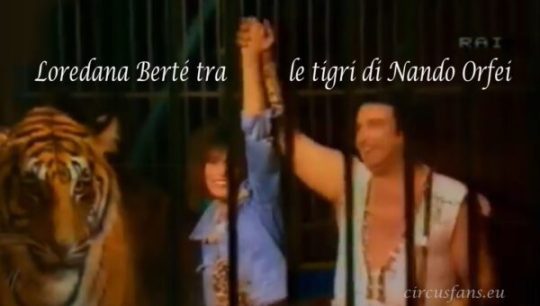
LOREDANA BERTE' CANTA TRA LE TIGRI DI NANDO ORFEI (1982) Dagli anni Cinquanta ai primi anni Novanta la gabbia dei grandi felini era un salotto in cui poteva accadere di tutto: eventi mediatici che attiravano l'attenzione del pubblico e le cui immagini rimbalzavano sui giornali (prima con le tavole della Tribuna Illustrata e della Domenica del Corriere poi con le foto sui quotidiani e le riprese video nei cinegiornali). Il barbiere che radeva il domatore, il brindisi con sportivi e autorità, il giornalista o fotoreporter che sfidava il pericolo, il tenore che teneva a bada i leoni e così via. Orlando in questo fu un maestro e a seguire Nando e Rinaldo seppero ereditare questa tradizione che a Nandino valse definitivamente la definizione di "domatore della televisione". Abbiamo già mostrato su queste pagine lo special del 1982 di Gianni Minà con l'intervista a pochi centimetri dalle tigri. GUARDA IL VIDEO Qui andiamo oltre con immagini (scovate dall'inarrestabile Mauro Cantoro) che ritraggono Loredana Berté cantare l'intera canzone "Per i tuoi occhi" all'interno della gabbia, al cospetto di 8 tigri tenute a bada da Nando Orfei. Al fine vediamo il saluto tra i due, il luminoso sorriso di Nando (che bastava da solo a conquistare la platea del pubblico sotto lo chapiteau e davanti al piccolo schermo) e sentiamo ruggire le tigri. Un reperto raro e dimenticato ma che ci ricorda di quanto fosse onorevole e prestigiosa la pista di segatura intrisa del magico odore degli animali qualche decina di anni fa. Il più, il 1982 fu un anno pazzesco per Nando Orfei che ricevette la Medaglia d'Argento per aver affrontato il leone a Napoli e aver salvato i bambini della scolaresca, ricevette la visita del presidente Pertini al Circo durante la permanenza a Roma, dove peraltro altri cantanti si esibirono nel suo circo, da Vasco Rossi (!) a Loretta Goggi. Davvero una passerella di vip e autorità.
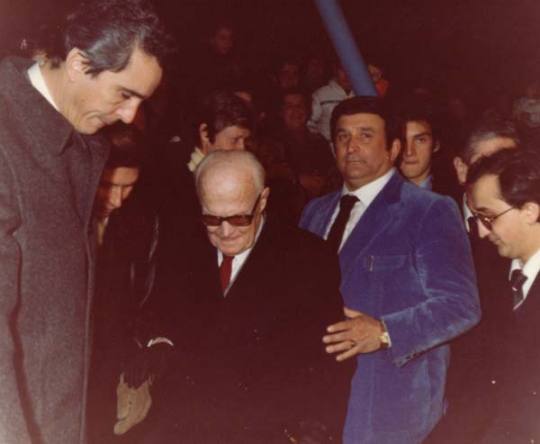
Non dimentichiamoci che non si tratta di una ripresa amatoriale, bensì di uno spezzone Rai trasmesso dalla tv di stato verosimilmente in un programma di grande ascolto. Come cambiano i tempi! Ciò che allora era spettacolo, vanto, orgoglio oggi è stigmatizzato, accusato, disprezzato con tanta quotidiana normalità da convincerci quasi che sia giusto così. Che sia giusto spazzarlo via con un colpo di spugna e tanto pentimento. Invece no. Certo, i tempi cambiano, i gusti si possono modificare, ma la rimozione culturale e la continua tendenza alla "cancel culture" è pericolosa e spesso intrisa di malafede.


Per raggiungere il gruppo l'Impresario Circense su Facebook cliccate sull'immagine sottostante

Iscriviti ai nostri canali social: Facebook, Instagram, Twitter, Pinterest, Tumblr, Flickr e Tik Tok E ..... per non perderti neanche una news iscriviti al canale Telegram di Circusfans Italia. Per raggiungerlo inquadra il QR Code con il tuo cellulare oppure clicca direttamente sull’immagine qui sotto.

Visita le nostre sezioni ARCHIVIO STORICO TOURNEE' Per rimanere sempre aggiornati sulle tappe dei circhi italiani LOREDANA BERTE' CANTA TRA LE TIGRI DI NANDO ORFEI (1982) Se questo articolo ti è piaciuto condividilo sui tuoi social utilizzando i bottoni che trovi qui di seguito Read the full article
0 notes
Text
Di nuovo all’opera!
Dopo questo lungo stop riprendono le repliche del “Barbiere di Seviglia” a Verona! Fa un po’ strano arrivare a Verona a fine agosto, con pochi turisti in giro e un aria fresca che sembra di essere già in autunno. Per chi volesse vederlo qua sotto il link della replica registrata dalla Rai. View this post on Instagram A post shared by Nanirossi (@nanirossi.it)
0 notes
Link
#Album#BettyBooom#Booombastic#ElectroSwingMixes#ElectroSwing#Featured#FutureSwing#House#NeoSwing#Techno#Vintage
0 notes
Text
Per Carnevale alla Fenice torna il Barbiere di Siviglia
Il Barbiere di Siviglia di Gioachino Rossini torna al Teatro La Fenice di Venezia, nell’allestimento storico firmato dal regista Bepi Morassi con le scene e i costumi di Lauro Crisman, con la direzione musicale di Renato Palumbo. Otto le recite in agenda, il 26 e 28 gennaio, 1, 3, 7, 9, 11 e 13 febbraio prossimi. La replica di sabato 3 febbraio sarà tramessa in diretta radiofonica su Rai…
View On WordPress
0 notes
Text
The Transformative Power of Artificial Intelligence: Shaping Lives Now and in the Future
Artificial Intelligence (AI) is rapidly becoming an integral part of our daily lives, influencing various aspects from healthcare to finance, and even our personal interactions. As we stand on the brink of a technological revolution, it’s crucial to understand how AI is shaping our present and what its future holds. AI in Our Daily Lives AI has already woven itself into the fabric of our…
0 notes
Text
14 ago 2023 19:40
LA STRAORDINARIA STORIA DELLE CENSURE IN RAI RACCONTATA DA VITO MOLINARI – IL 93ENNE REGISTA DI OLTRE 200 TRASMISSIONI DELLA TV PUBBLICA, COMPRESA QUELLA DELL'ESORDIO, IL 3 GENNAIO 1954, RICORDA: “UN FESSO DI DEMOCRISTIANO FECE UN’INTERPELLANZA PERCHÉ FRANCA RAME NON MOSTRASSE LE DUE GAMBE CONTEMPORANEAMENTE MA UNA PER VOLTA! – ERA VIETATO PRONUNCIARE ‘MEMBRO’ O ‘AMANTE’ E I DERIVATI DELLA PAROLA ‘FICA’. A UN TELECRONISTA SPORTIVO FU IMPEDITO DI CITARE IL BENFICA” - E POI LO SCANDALO “CANZONISSIMA ’62”, LO SKETCH DI TOGNAZZI E VIANELLO SU GRONCHI... – VIDEO -
Estratto dell’articolo di Antonio Gnoli per “Robinson – la Repubblica”
È stato per più di trent’anni il “domatore” di comici e soubrette televisivi. La televisione, che qualcuno definisce buona, che oltre all’intrattenimento ha contribuito alla crescita di un paese entrato tardi nella modernità. Vito Molinari, 93 anni, è una delle ultime memorie storiche del piccolo schermo.
[…] Ha scritto memorie sulla Rai, sulle persone che ha incontrato e con le quali ha lavorato. Il suo esordio coincise con quello della tv.
Che ricordo ha?
«Il 3 gennaio 1954 diressi il programma inaugurale della televisione. Durò un’ora dalle 11 alle 12. Facevo vedere le telecamere; poi c’era un filmato che spiegava come le immagini si propagassero nelle varie città; infine ci fu un cocktail e la benedizione del vescovo».
[…] Che Rai era quella dei primi anni Cinquanta?
«Bigotta, ma anche destinata a crescere».
Quando dice bigotta a cosa si riferisce?
«All’asfissiante dominio democristiano. Un potere condiviso con la Chiesa cattolica. Non a caso come amministratore delegato fu chiamato Filiberto Guala. Si dimise dopo un paio di anni e si rinchiuse in un convento di trappisti. Un personaggio singolare».
Nel senso?
«Entrò in Rai dichiarando la sua assoluta estraneità al mondo della comunicazione e dello spettacolo. Non era mai stato al cinema e non sapeva cosa fosse quell’oggetto che qualcuno aveva misteriosamente chiamato televisione. Gli fecero visionare Il barbiere di Siviglia, regia di Franco Enriques. Il commento di Guala fu che le immagini disturbavano la musica e che forse sarebbe stato meglio trasmettere l’evento a schermo scuro. Gli spiegarono che la televisione era una cosa ben diversa dalla radio. E poi, a voler giustificare lì la sua presenza, si definì un modesto crociato chiamato in Rai per cacciare pederasti e comunisti».
Fu però anche un innovatore.
«A un certo punto si aprì alla società civile. Riuscì a far passare un concorso per esterni in cui furono assunti personaggi che avrebbero fatto la storia della televisione, come Angelo Guglielmi, Enrico Vaime, Piero Angela; altri — come Umberto Eco, Gianni Vattimo, Furio Colombo — avrebbero trovato altrove la loro riuscita professionale».
Lei che posto si è ritagliato?
«Credo, senza falsa modestia, di aver contribuito a quella televisione che ancora si rimpiange».
Chi c’era con lei agli esordi?
«Con me entrarono Franco Enriques, Eros Macchi, Mario Landi e altri. Ciascuno ha cercato di inventarsi una propria televisione».
Cosa aveva quella televisione di diverso?
«Per dirla con una battuta: non era sbracata come lo è oggi».
Però era anche molto imbrigliata, sorvegliatissima.
«Questo è vero, ho dovuto fronteggiare non so quante censure. Ma se penso alla professionalità che quella televisione esprimeva mi viene da piangere al pensiero per come si è ridotta».
Della tv di oggi chi le interessa?
«Come uomini di spettacolo Renzo Arbore, a suo modo geniale perché ha inventato un nuovo linguaggio. E poi Fiorello. Ma sfondo porte aperte».
Cosa le piace di Fiorello?
«La naturalezza in tutto quel che fa. Il più bravo di tutti. Potrebbe rivoluzionare il linguaggio televisivo. Ma credo abbia paura di sbagliare e per questo si inventa orari strani e interventi brevi».
A proposito di censura ci fu un famoso episodio che la riguardò.
«Più d’uno, a quale si riferisce?».
Quello in cui coinvolgeste il presidente della Repubblica di allora: Giovanni Gronchi.
«Il programma era Un due tre,con Ugo Tognazzi e Raimondo Vianello. Accadde che Giovanni Gronchi invitò Charles de Gaulle in visita in Italia, a una prima della Scala. Erano sul palco presidenziale e quando Gronchi stava per sedersi, qualcuno spostò la sua poltrona di quel poco che lo fece rovinare a terra. La televisione riprese quella scena. E Tognazzi e Vianello ne fecero la parodia».
A quel punto?
«Lo sketch in cui Tognazzi toglie la sedia da sotto il sedere di Vianello fu visto come uno sberleffo, un’onta da lavare col sangue dei due comici. Il programma venne chiuso, era il 1959».
Non c’era ancora Bernabei?
«No, arrivò come direttore generale nel 1961».
Cosa pensa del suo operato?
«Fu un interprete assoluto. Ma doveva eseguire uno spartito scritto dal potere democristiano. In particolare da Amintore Fanfani. E quella parte, non c’è dubbio, l’ha svolta con una intelligenza che sfiorava il fanatismo ideologico».
youtube
dario fo - canzonissima 1962
Si stenta oggi a pensare a una rigidità così ferrea.
«Era un’altra epoca e occorreva combattere per non cedere a ogni veto posto dall’ultimo cretino. Una volta un fesso di democristiano fece un’interpellanza parlamentare perché in televisione Franca Rame che ballava e cantava non mostrasse le due gambe contemporaneamente ma una per volta!
Girava anche una specie di manuale per come parlare. Il lessico andava depurato. Era una ossessione della dirigenza. Per esempio non si poteva pronunciare la parola “membro” o “amante”. Erano banditi anche i derivati della parola “fica”. A un telecronista sportivo fu vietato di pronunciare Benfica, dovendo limitarsi a dire la squadra di calcio avversaria. Un accanimento surreale».
A proposito di Franca Rame, lei ha lavorato anche con Dario Fo.
«Facemmo Canzonissima del 1962. Con Dario scrivemmo i testi e registrammo 12 delle 13 puntate. Ovviamente il tutto doveva passare al vaglio della direzione».
[…]
Cosa accadde?
«A parte alcune obiezioni che comportarono lievi modifiche, il grosso dei testi passò indenne. Almeno così sembrò. Quel rilievo fatto a Franca Rame troppo scosciata accadde nella prima puntata. Poi ci venne in mente di aggiungere uno sketch nel quale si denunciavano i rischi del lavoro in fabbrica. La direzione volle visionare il testo. Fu lo stesso Bernabei a chiamarci al telefono».
E voi gli leggeste il testo?
«Fu Dario a parlargli. C’era già un clima da centrosinistra.
Ci sembrava che una satira contro le durezze e i pericoli del lavoro in fabbrica fosse in linea con un paese che stava cambiando».
Ma lo sketch in cosa consisteva?
«La zia di un operaio di una fabbrica di insaccati andava a trovare il nipote, scivolando finiva negli ingranaggi di un enorme tritacarne, ma la produzione non poteva essere interrotta. Il giorno dopo l’operaio riceveva 150 scatolette della zia. Bernabei trovò l’episodio disgustoso e inappropriato. Dario insisteva che quello era un modo per denunciare il lavoro in fabbrica. Ci fu una grande litigata con Bernabei che troncò la conversazione. Ma l’episodio che fece traboccare il vaso fu quello legato agli incidenti mortali sui cantieri edili, non ce lo fecero mai passare e a quel punto ritirammo le nostre firme dal programma».
Non provaste una mediazione?
«Non ci fu verso, Bernabei era irremovibile. Quell’episodio concluse la presenza televisiva di Fo e Franca Rame. Sarebbero tornati 15 anni dopo con la presidenza di Paolo Grassi».
[…]
Nel suo libro “La mia Rai” dedica a suo padre alcune pagine piuttosto drammatiche.
«Aderì alla Repubblica sociale di Salò. Era stato fascista come tanti italiani ma il fatto che un uomo sostanzialmente mite sposasse la causa del duce e dei tedeschi resta per me un mistero oltre che un dramma».
Gli ha mai chiesto ragione di quella scelta?
«Non ne ha mai voluto parlare, la sola cosa che mi disse è che nella vita bisogna essere coerenti».
Non gli fece notare che la coerenza non poteva essere un valore di fronte all’enormità degli eccidi che i tedeschi e i fascisti avevano compiuto?
«Per lui cambiare casacca, un vizio molto italiano, era il peggiore dei mali. Dopo la guerra fu epurato, gli vennero tolti il lavoro e lo stipendio. Furono anni duri. Ricordo che mi dovetti impiegare in una società di noleggio di pellicole cinematografiche per portare a casa qualche lira. In seguito subì un processo, fu scagionato, riottenne il posto e finì la sua carriera come Procuratore superiore delle imposte dirette. Per me la sua vicenda è stato un trauma e un dolore».
Un altro dolore è stata la morte di sua moglie.
«Hilda si ammalò di cancro, fu operata nel 1989 ed è morta nel 1994. Negli ultimi anni abbiamo passato molto tempo qui, nel golfo del Tigullio».
Con la televisione quando ha chiuso?
«Negli anni della malattia di mia moglie. Comunque mi dimisi dalla tv nei primi anni Sessanta, volevo continuare a occuparmi di teatro e scrivere libri. Cominciò con la Rai il periodo di collaborazione».
Cosa le resta dell’esperienza televisiva?
«Tutto quello che la memoria è riuscita a trattenere, i Caroselli che ho fatto, più di 500, le regie ai programmi, i volti e le persone che ho conosciuto, frequentato e che ho accompagnato ai loro esordi».
A chi pensa?
«A trasmissioni come L’amico del giaguaro con Gino Bramieri, Raffaele Pisu, Marisa Del Frate. Seguii il debutto televisivo di Paolo Poli, che poi fu tenuto per anni fuori dalla televisione, per via che non faceva mistero delle sue preferenze sessuali; Walter Chiari, un talento assoluto, generoso, pigro con una capacità di improvvisare unica; Cochi e Renato: dovetti combattere per fare accettare la loro comicità surreale; Fred Buscaglione che in privato era l’opposto dello smargiasso in doppio petto da gangster che cantava Eri piccola così. Morì, a un incrocio schiantandosi con la sua auto contro un camion».
Fu una delle prime morti mediatiche.
«Era il febbraio del 1960, Buscaglione rincasava all’alba dopo una notte in cui aveva cantato in un night. Nel pomeriggio avevamo registrato uno sketch per Carosello sulla birra. Ironia della sorte pronunciò alla fine la fatidica battuta: “Solo chi beve birra campa cent’anni”. Morì che ne aveva 39. L’azienda che produceva birra cancellò lo spot».
Lei è stato anche lo scopritore di Villaggio.
«No, a scoprirlo fu Maurizio Costanzo. Lo avevo conosciuto a Genova e mi chiese di recitare per il teatro universitario che dirigevo. Era magro, occhi azzurri, voce flautata. Ambizioso come pochi, voleva recitare parti serie. Non colsi immediatamente la sua vena di comicità aggressiva. Fu Costanzo, che lo portò in un cabaret romano, a tirargliela fuori. Compresi allora il suo potenziale e lo utilizzai nel personaggio del dottor Kranz e in quello di Giandomenico Fracchia. La Rai al tempo cercava nuovi comici, nuove figure. Feci debuttare Oreste Lionello, Gianfranco Funari, Enrico Montesano. Ma il più grande di tutti perché colto, spiritoso, surreale, fulminante nelle sue battute, fu Marcello Marchesi».
Ingiustamente dimenticato.
«Era un vulcano di idee e un talento della scrittura. Diventammo amici e ne rimpiango la prematura scomparsa».
Sono in molti che ha conosciuto e che non ci sono più.
«A volte mi sento un sopravvissuto di lusso. Come diceva Marchesi: l’importante è che la morte ci trovi vivi».
0 notes
Text
went to Rai3 and got super excited thinking I was going to get a little pre-bedtime bite of Il Barbiere di Siviglia but then I realized that between my VPN (assuring the Rai website that I'm totally in Milano rn) and my cookies (telling the Rai website that it's 21:50 where I am), something did a stupid and the Rai website only told me I could watch the opera bc it put 2 and 2 together and decided I was temporarily several hours in the past : )
it's like. 5:10AM over there.
So what I got after an error message was the early-AM notizie about the current COVID situation in Rome. Which was interesting nonetheless! But it was not delivered in aria form, probably because that'd be a bit much even for the frightening people who can wake up and watch notizie before even 5AM.
1 note
·
View note
Photo
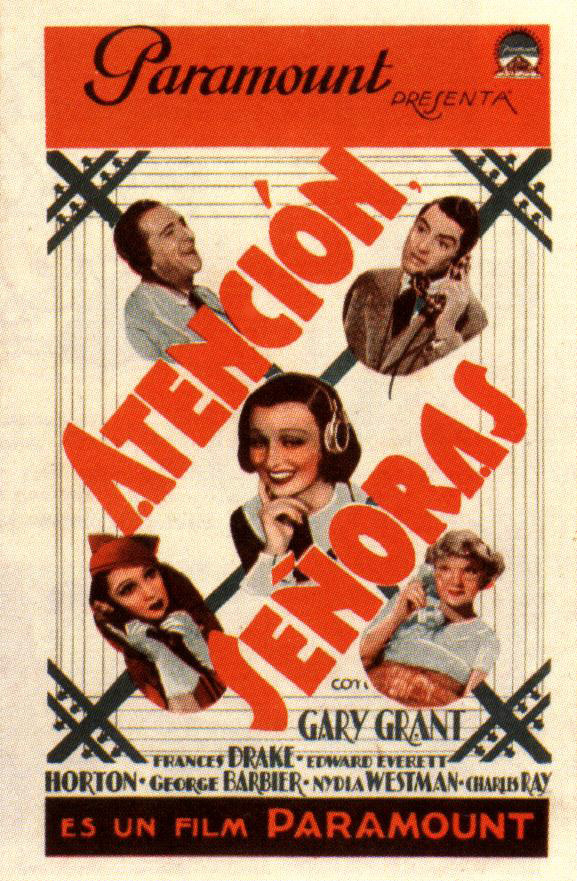
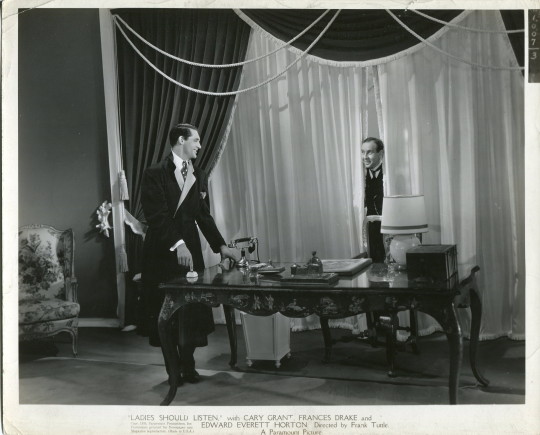
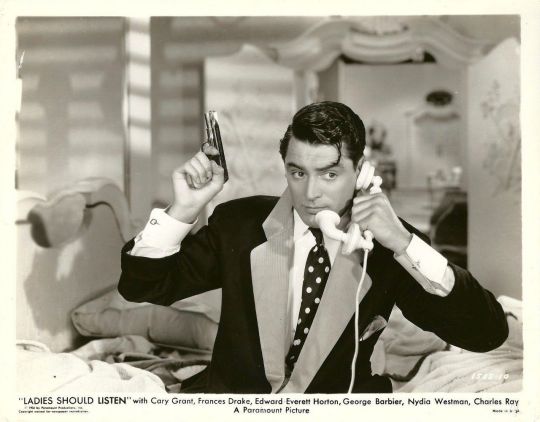
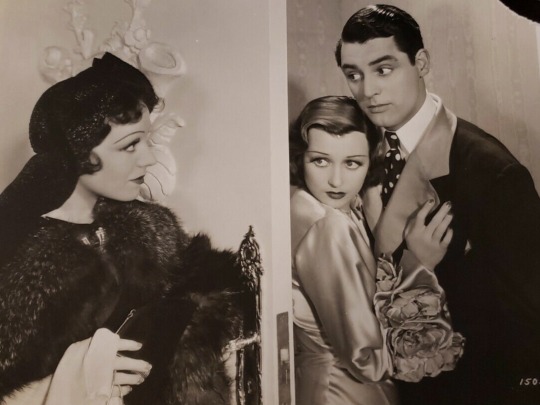

Ladies Should Listen (1934) Frank Tuttle
December 4th 2022
#ladies should listen#1934#frank tuttle#cary grant#frances drake#nydia westman#edward everett horton#charles ray#rafael corio#rosita moreno#george barbier#charles arnt#ann sheridan#pre-code
6 notes
·
View notes
Text
Dust Volume 7, Number 5

Sarah Louise
A week or two before this Dust’s deadline, we got our first tour announcement by email in more than a year. It was the first of deluge, as live music looks to be coming back with a vengeance starting this summer and really picking up steam around September. Meanwhile, we celebrate our newly vaxxed (or for our Canadian correspondents half-vaxxed) status with tentative steps outside. Your editor had her first beer at a brew pub in mid-May, and it was stupendous. Also stupendous, the onslaught of new music, which has, if anything, accelerated. This month, contributors include all the regulars plus a few new people: Jennifer Kelly, Bill Meyer, Patrick Masterson, Ray Garraty, Tim Clarke, Andrew Forell, Ian Mathers, Bryon Hayes, Jonathan Shaw and Chris Liberato. Happy spring, happy normal and happy listening!
Amulets — Blooming (The Flenser)
Blooming by AMULETS
Like a lot of us, Portland-based noise artist Randall Taylor discovered the solace of long walks during the pandemic. His work, which has always used tape degradation to explore the intersection of time, loss and technology, shifted to incorporate another source of decay: the natural world. So, in opening salvo, “Blooming,” alongside blistering onslaughts of eroded guitar sound, it is possible to hear the sounds of a fertile garden — birds, insects, air movement. You can nearly smell the flowers and feel the sunshine on your skin. “The New Normal” explores sounds of creaking, friction-y word and metal, alongside pristine chimes of synthetic tone. It is uneasy, with skittering string-like squeaks and swoops, but also deeply meditative; it shifts from moment to moment from anxiety to provisional acceptance, much as we all did last year, staring out our windows. Overall, the tone is elegiac, gorgeous, but Randall does not hesitate to introduce dissonance. “Heaviest Weight” thunders with frayed bass tones, a weight and a threat in their subliminal pulse. The contrast between that ominous sound and purer, clearer layers of melody, makes for unsettling listening—are we at war or peace, happy or sad, agitated or calm? And yet, perhaps that’s the point, that the past year has been swirl of feelings, boredom alongside anxiety, hope lighting the corners of our listlessness, the smell of flowers pleasing but faintly reminiscent of funerals. Blooming decocts this mix into sound.
Jennifer Kelly
Astute Palate — S-T (Petty Bunco)
Astute Palate by Astute Palate
Astute Palate is a hastily assembled group of rockers summoned to support David Nance in Philly on a date when he couldn’t bring the David Nance Band. Participants included Richie Records proprietor Richie Charles, Lantern’s Emily Robb, Writhing Squares/Purling Hiss/all around Philadelphia regular Daniel Provenzano on bass and, of course, Nance himself, all huddled together in Robb’s recording studio for a weekend together. None of this origin story does justice, however, to the pure liquid fire of this one-off musical collaboration, dominated by Nance’s viscous, distorted blues-inflected guitar wail, but knocked sideways by brute force drumming, wild hypnotic bass lines and the ritual incantation of Nance (and later Robb) singing. The long “Stall Out” does anything but, rampaging free-range in unbridled Crazy Horse/Allmans-style abandon for close to ten minutes without a single sputter. “A Little Proof” is somehow simultaneously heavier and more country, spinning out the soul-blues jams like a younger, unrulier cousin to MC5. “Treadin’ Schuylkill” gives Provenzano the spotlight, opening with a growling bass solo soon joined by heavy psych guitars (a nod, perhaps, to the illustrious locals in Bardo Pond). If Nance et. al. can pull stuff this fine out in a stray road warrior weekend, what are the rest of you doing with your lives?
Jennifer Kelly
Axis: Sova — Fractal (God?)
Fractal - EP by Axis: Sova
Axis: Sova is a combo of three Chicago guys plus one drum machine, which had already been inactive for two or three seasons before the initial COVID lockdown. This digital EP is their way of clearing up some business that could no longer remain undone. The title tune, “Fractal USA,” is a remake of a song from the early days, when the “band” was Brett Sova’s solo project, to full-on, no your pants aren’t tight enough rock band. They just needed you to know about the evolution, you see, so go ahead, do some scissor kicks and gurn while they windmill away; you have enough money saved up from not seeing live music to pay the inevitable chiropractor bill. “Caramel” hypothesizes that a Cluster song that’s played twice as loud and twice as long is twice as good; not sure if I agree, but it’s still not bad at all. Maybe you got a little weird after a few months of putting on your best mask for your daily trip to see if the stimulus check was in the mailbox? The Brenda Ray-meets-Old Black mash up, “(Don’t Wanna Have That) Dream,” is proof that while you were alone, you weren’t alone. If you’ve made it this far, you don’t need to have the fourth track described, so let’s just say that it’s longer.
Bill Meyer
Mattie Barbier — Three Spaces (self-released)
three spaces by mattie barbier
While perhaps best known as half of the trombone-centric new music duo RAGE Thormbones, Mattie Barbier is a member of several other combos and a sonic researcher under their own name. Three Spaces, which is a single, album-length sound file, has the air of experimentation about it. “What do I do,” one can imagine Barbier asking themself, “when I can’t play with other people?” Make music at home, and out of what’s at home, is the obvious answer. But doing isn’t the only point here; the outcome also matters, and while what Barbier has accomplished with Three Spaces sounds quite different from the RAGE Thormbones live experience, it registers quite strongly. Barbier has combined long tones and melodic fragments played on euphonium, trombone and reed organ, that were recorded both inside and outside of their home. Carefully layered, the source material combines into a sound rather like a bell’s toll, which over the course of nearly 39 minutes swells and recedes, but never quite decays; it ends with an imposed rather than natural fade-out. The sound is as deep as it is expansive, inviting the listener to let themselves fall ever father into its realm.
Bill Meyer
Beneath — On Tilt EP (Hemlock Recordings)
On Tilt EP by Beneath
One of the more pleasant surprises this year is the resuscitation of Untold’s Hemlock Recordings imprint. A vital voice in the post-dubstep fracas at the turn of the ‘10s thanks to releases from Hessle Audio’s Pearson Sound (when he was still Ramadanman) and Pangaea, James Blake, FaltyDL and Hodge to name but a handful, the label went dormant following a Ploy 12” in 2017 before the surprise announcement of Londoner Beneath’s On Tilt, which sounds every bit the sensible alliance in practice it looks on paper: These are low-end rumblers with irregular rhythms and spare melodic tics that worm their way into your brain in the best bone-humming fashion (see “Shambling” or “Lesser Circulation” for a good example). Who knows how long the return will last, but for a certain stripe of DMZ-damaged devotee and pretty much no one else, it’ll feel good to have some Hemlock in your life again. Tilt back, pour in.
Patrick Masterson
Black Spirit— El Sueño De La Razón Produce Monstruos (Infinite Night Records)
youtube
More metal comes from South America than Spain, but these Europeans clear the high bar set by Latin America scenesters. The album’s title states that it was inspired by “El Sueño De La Razón Produce Monstruos.” That can testify both to lasting influence of Goya’s art and to the laziness of the current culture which seeks inspiration only from the most popular pictorial art of the past. The track “Ignorance and The Grotesque” perfectly captures the whole mood of the disc: it balances ignorant speeds, undecipherable vocals and grotesque parts with piano interludes and doom-ish atmosphere. It would be better without the grotesque, but that’s probably part of the baggage.
Ray Garraty
Burial + Blackdown — Shock Power of Love EP (Keysound Recordings)
Shock Power of Love EP by Burial
You might worry, occasionally, that Burial was becoming a victim of diminishing returns. Here, as ever, he uses a narrow palette to create tracks that few can emulate. However, even though the music has its rewards, it doesn’t clear the very high bar that his previous work has set. Thus “Dark Gethsemane” rides a 4/4 beat, angelic murmurs, vinyl crackle and a tightly ratcheted build that morphs into a sermon led by the repeated invocation “We must shock this nation with the power of love.” As his vocal samples become more explicit, the mystery of his music fades. This is all promise and no real resolution. “Space Cadet’ likewise sounds both gorgeous and minor with its soul gospel refrain “Take Me Higher” over an old-school jungle beat. At six plus minutes it would have been enough. It continues another three with an almost cartoonish second movement that lacks the subtlety that characterizes Burial’s best work.
Andrew Forell
Colleen — The Tunnel and the Clearing (Thrill Jockey)
The Tunnel and the Clearing by Colleen
While COVID messed with most people’s lives, it was both an endgame and an opportunity for Cécile Schott, the Frenchwoman who records under the name Colleen. She was just coming out of a series of health and personal dislocations, which resulted in her being newly healthy but alone in a new town just as the lockdown came down. Clearly, this was not a time for half measures, so she selected an entirely new instrumental set-up and settled in to make a record that reflected what she’d been through. Out went the viola da gamba and melodica that have figured prominently on her last few albums; in came a Moog synthesizer, a Yamaha organ, a tape echo and a drum machine.
Colleen’s voice, of course, remains the same. Airy and precise, her delivery doesn’t match the gravity of the experiences her songs describe. But that sense of remove is, perhaps, a reflection of one of adversity’s lessons; if you don’t stay stuck, you can wind up somewhere quite different. Between the keyboards’ cycling melodies and the drum machine’s fizzy beats, the music on The Tunnel and the Clearing imparts a sense of motion that carries her light voice along for the ride, dropping painful sentiments and letting them fall behind.
Bill Meyer
Current Joys — Voyager (Secretly Canadian)
youtube
Nick Rattigan has been releasing music under the name Current Joys since 2013, and Voyager is his latest offering. It’s a dramatic and often brilliant collection of songs, bringing to mind the urgent rhythmic drive of Spoon, the dour grandeur of The Cure and the unapologetic emotional heft of Bright Eyes or early Arcade Fire. On Voyager’s standout, “American Honey,” a simple strummed backing and Rattigan’s vocal delivery are potent enough, but it’s the string section that proves devastating, cycling around for multiple punches to the gut. While more stripped-back songs such as “Big Star” and “The Spirit or the Curse” offer some respite along the way, Voyager does prove a little unwieldy. With 16 tracks clocking in at nearly an hour, the album’s execution doesn’t quite live up to its ambition. The wonky tom-tom rhythms of “Breaking the Waves” are more distracting than interesting; a serviceable cover of Rowland S. Howard’s “Shivers” feels more like an acknowledgment of influence than a striking interpretation; and the combined six minutes of the two-part instrumental title track may have worked better as shorter interludes. Nevertheless, plenty of Voyager’s tracks demonstrate Rattigan’s knack for a raw, emotive indie-rock tune.
Tim Clarke
Ducks Ltd — Get Bleak EP (Carpark Records)
youtube
Toronto duo Ducks Ltd celebrates signing to Carpark with an expanded re-release of their 2018 debut EP Get Bleak. The pair — Tom Mcgreevy on vocals, rhythm and bass guitars and Evan Lewis on lead guitar — bonded over a shared love of 1980s indie bands. Their intricately constructed guitar interplay carries the DNA of Postcard and C86 over meaty bass lines that evoke Mighty Mighty as much as Orange Juice and McCarthy. The sprightly music belies the miserablism of the lyrics that focus on FOMO, poor decisions, screen induced isolation, the corrosive impact of gentrification and gig economies. Mcgreevy and Lewis don’t wallow, however. Their jaunty jangle is a paean to the joys of jumping about and singing along with those new favorite songs that suddenly mean everything and will stick with you long after the world’s shit slopes your shoulders.
Andrew Forell
Field Music — Flat White Moon (Memphis Industries)
youtube
It’s easy to take Field Music for granted. Since 2005, the Brewis brothers have been making smartly composed and tightly executed guitar pop with obvious debts to The Beatles and XTC, and all their albums have fallen somewhere along the continuum from good to great (my personal favorites are 2010’s Measure and 2012’s Plumb). Album number eight, Flat White Moon, features the usual balance between Peter’s more pensive, bittersweet numbers with greater focus on piano and strings, such as “Orion From the Street” and “When You Last Heard From Linda,” and David’s funkier, more staccato cuts, such as “No Pressure” and “I’m the One Who Wants to Be With You.” Twelve songs, 40 minutes, tunes for days — what’s not to love? If you’ve yet to get acquainted with Field Music, Flat White Moon is as good an introduction as any.
Tim Clarke
Gabby Fluke-Mogul/Jacob Felix Heule/Kanoko Nishi-Smith — Non-Dweller (Humbler)
non-dweller by gabby fluke-mogul, Jacob Felix Heule, & Kanoko Nishi-Smith
With Non-Dweller, we have a trio of Bay-Area improvisers who certainly do not reside in one place for very long. There is an agitated freneticism about their interactions here, the performers acting like electrons seeking to release energy and break out of orbit. Each player brings a unique collection of timbres to the party with their implement of choice. Heule is a percussionist by trade yet focuses on extended techniques — mainly friction-based — as he wrests an unholy wail from the maw of his bass drum. Fluke-Mogul’s violin sways between tone generator and noise source. Nishi-Smith is a classically trained pianist who here is bowing and plucking the koto, or Japanese zither. The trio spend most of their time in sparring mode, their energies unleashed with synchrony as if in an elaborate dance. It is clear they have collaborated before. Heule and Nishi-Smith have been at it for over a decade; Fluke-Mogul joined the party in 2019. The most gorgeous moments happen when all three players are focused on friction: Heule slides across his drum, Fluke-Mogul soars with their violin and Nishi-Smith gracefully bows her koto. The energy is focused and particles collide, creating waves of tone. The players wrestle intensity into submission, and the ensuing sonorities are unmissable.
Bryon Hayes
FMB DZ — War Zone (Fast Money Boyz \ EMPIRE)
youtube
Ever since FMB DZ got shot and moved out of Detroit, he has continued to release angry music. (He may not be more productive after the assault, but he’s certainly not less so.) War Zone is his latest effort, along with The Gift 3 and Ape Season, and DZ is back in his paranoiac mode and ready for vengeance. That’s hardly unusual in this type of music but DZ stands out because he’s a bit angrier, a bit more pressing and a bit more gifted than the next man. He doesn’t outdo himself in this tape, but rather mostly follows the blueprint of Ape Season. The standout track is “Spin Again.”
Ray Garraty
Ian M Fraser — Berserk (Superpang)
Berserk by Ian M Fraser
Ian M Fraser is kind enough to provide details about how he created and edited Berserk, although relatively few listeners are going to really know what “nonlinear feedback systems and waveset synthesis” are, let alone “sensormonitor primitives auditory perception software”. And fewer still will be able to focus on what that might mean while Berserk is actually playing, because the output of those programs and systems is immediately, viscerally clear. If a computer were actually capable of going rabid, feral, well, berserk, the human mind might imagine it sounds something like this. Over four shorter tracks and the relatively epic 8:26 of “The Cannibal,” Fraser either coaxes or allows (or both) his tools into the equivalent of something like what someone who knew very little about both genres might imagine is like a power electronics act playing free jazz or vice versa. It is absolutely viscerally thrilling (albeit probably easier to repeat at this length of 16 minutes than, say, 50) and will do the track the next time you feel like your brain needs a good hard scrub.
Ian Mathers
Human Failure — Crown on the Head of a King of Mud (Sentient Ruin Laboratories)
Crown on the Head of a King of Mud by Human Failure
It’s tough to figure out if the band’s name is meant specifically to apply to D. Cornejo (sole member of Human Failure) or to the general field of human failure, which grows ever more capacious. Whatever the intent, Human Failure makes thoroughly unlovable music, pitched somewhere on the continuum that runs from the primitivist death metal to stenchcore to harsh noise. This reviewer is especially fond (yep, somehow that’s the only word for it) of the title track of this 10” record: “Crown on the Head of a King of Mud” sloughs and slogs along for two minutes, sort of like one of the ripest zombies in Romero’s Day of the Dead (1985), wandering about and slowly falling to pieces in Florida’s tumid heat. Just as that last bit of flesh is poised to slide from bone, the song unexpectedly breaks into a run. Where is it going? What’s the rush? No one knows. Things eventually bottom out into “Disassembling Morality,” a static-and-distortion laden electronic interlude that might squeak and spark for a bit too long — but then “Your Hope Is a Noose” shambles into the frame. That zombie seems to have found some equally noisome and truculent friends. They djent and pogo around for a while, and the song has a lot more fun than seems called for by the band name. Cornejo might be pissed off by the myriad manmade disasters and outright catastrophes that burden the earthball (he’s sure angry as heck about something…). But the record ends up being sort of successful, if deafening, grinding, growling stench is on the agenda. All things considered, why wouldn’t it be?
Jonathan Shaw
Insub Meta Orchestra — Ten / Sync (Insub)
Ten / Sync by INSUB META ORCHESTRA
Ten / Sync was recorded in September, 2020; not exactly lockdown time, but certainly not out of the pandemic woods. It’s no small task to keep any 50-strong orchestra going, let alone one devoted to experimental music. So, if you already have one, then having it perform during a pandemic is just another challenge among many. So, the Swiss-based orchestra assembled three groups of musicians, numbering 31 in all, and assembled their contributions during post-production. While this did not provide the social experience that IMO’s gatherings usually impart to participants, an outcome that just isn’t the same seems awfully representative of the time, right? And since one Insub Meta Orchestra subspeciality is making music that sounds like it was performed by many fewer players than were actually present, this collection of sustained chords concealing tiny actions and apparently disassembled passages is actually very representative of the ensemble’s music.
Bill Meyer
Amirtha Kidambi & Matteo Liberatore — Neutral Love (Astral Editions)
Neutral Love by Amirtha Kidambi & Matteo Liberatore
With her own group, the Elder Ones, and in Mary Halvorson’s Code Girl, singer Amirtha Kidambi shows how far you can take a song while still giving the meanings of words and the boundaries of form their dues. But Neutral Love, like her two tapes with Lea Bertucci, explores the territory outside the tower of song. The main structures for this improvised encounter with electric guitarist Matteo Liberatore seem to be a shared agreement to exclude certain options. Song form and overt displays of chops are right out; the patient manipulation of sounds is where it’s at. Liberatore opts mostly for swelling and subsiding resonations, while Kidambi spends a lot of time finding out what’s hiding at the back of her throat, drawing it out, and then tying it into elaborate shapes. Patient and eerie, these four tracks find a place adjacent to Charalambides at their most abstract, and make it their own.
Bill Meyer
Kosmodemonic — Liminal Light (Transylvanian Recordings)
KOSMODEMONIC - LIMINAL LIGHT by KOSMODEMONIC
NYC outfit Kosmodemonic is among the recent wave of metal bands attempting to effect an organic-sounding synthesis of numerous subgenres: a slurry of sludge, a bit of black metal, a dose of doom, and a hit or two of the lysergic. When it works — as it does on a number of tracks on the band’s long new cassette Liminal Light — it’s an exciting sound. Songs like “Moirai” and “Broken Crown” manage to couple tuneful riffs, dirty tone and a muscular bottom end in ways that feel thumping, groovy and pretty weird. You’ll want to bump your butt around even as you’re looking for something to break. But the tape is pretty long, and the further afield Kosmodemonic gets from that mid-tempo groove, the more middling (and sometimes muddled) the material sounds. “With Majesty” can’t quite find its rhythmic footing in its more technical passages, and the song’s sludgier sections feel like compromises, rather than interesting maneuvers. But the record begins and finishes with really strong songs. Both “Drown in Drone” and “Unnaming Unlearning” embrace scale, letting their big riffs rip. When “Unnaming Unlearning” slips into complex sections of blackened and distorted dissonance, the drama surges. Formal experiment and manipulation of mood fold into each other. The song gets interesting, even as it’s reaching for a peak. And then it ends, suddenly, violently. It’s pretty good. Your impulse is to flip the tape and hear it again, which is just what Kosmodemonic wants you to do. Well played, dudes.
Jonathan Shaw
Sarah Louise — Earth Bow (Self-Released)
Earth Bow by Sarah Louise
Asheville-based songwriter Sarah Louise wants to be your personal nature interpreter. The titles of her recordings, from her debut Field Guide through Deeper Woods and Nighttime Birds and Morning Stars are like planetary signposts pointing to a more intimate relationship with our planet as a living organism. With each successive release, her music has also become more and more organic sounding, culminating with Earth Bow, in which Louise herself is arms deep in humus, communing with birds and insects. Recordings of creation feature prominently; katydids, spring peeper frogs, a creek and various birds are credited as providing additional singing, augmenting the artist’s own mellifluous voice. For a recording in which the track titles and lyrics are focused on nature and Louise’s experiences therein, there are a lot of digital elements. Her 12-string guitar is prominent in places, but synths are everywhere: in the background, bouncing around like shooting stars, and mimicking the various fauna that they accompany. Yet the earthly and the machine-made are not juxtaposed, they are blended. The vocals, which center the recordings, tie both elements together nicely. Earth Bow is a tasty concoction, in which a variety of ingredients are married in botanical bliss.
Bryon Hayes
Le Mav — “Supersonic (Feat. Tay Iwar)” (Immaculate Taste)
youtube
Nigeria’s alté scene has been bubbling for a couple of years now on the backs of guys like Odunsi (The Engine) and Santi, and Gabriel Obi bka Le Mav is no stranger to the fray, having produced Santi’s “Sparky,” Aylø and a recurring favorite of his, singer Tay Iwar. The two have already collaborated at length (for songs off Iwar’s debut album Gemini in 2019, as well as the entirety of last year’s Gold EP), so the comfort level here is established. It shows: Iwar’s smooth-as vocals match Le Mav’s breezy piano descent and gentle rhythmic shuffle in an easygoing song that matches anything you might hear coming from Miguel, Frank Ocean or the Sun-El Musician orbit. “If it feels right, touch the sky,” Iwar suggests early on. Well, don’t mind if I do.
Patrick Masterson
Sugar Minott — “I Remember Mama” (Emotional Rescue)
I Remember Mama by Sugar Minott
At some point after Lincoln Barrington Minott had left Kingston and his early dancehall and lovers rock legacy with Studio One and Black Roots behind for cooler climates and the old world of London, he ran into producer Steve Parr at the Wackies offices. Story goes that the two decided to start up Sound Design Studio with the intent to record and mix for ads, film and music — but scant evidence of this idea exists beyond “I Remember Mama,” released on 7” and 12” in 1985 and reissued for the first time since via Stuart Leath and his long-trusted Emotional Rescue imprint. Parr does most of the work on the recording (Andy MacDonald shines on tenor sax and Paul Uden guitar in the original credits), but it’s all about the sweetness Sugar brings to the table: With backing from two accomplished performers in their own right, Janette Sewell and Shola Phillips, Minott’s naturally relaxed delivery shines through on this. “Sound Design” is a dubbier instrumental version that retains Sewell’s and Phillips’ vocals, and Dan Tyler (half of Idjut Boys) provides an even spacier, handclap-laden 11-minute remix, but while both variants are excellent, the boogie of the original is unassailable. Look for the vinyl to hit in July.
Patrick Masterson
Jessica Ackerley — Morning/mourning (Cacophonous Revival)
Morning/mourning by Jessica Ackerley
It makes sense that Wendy Eisenberg wrote the liner notes to Morning/mourning, since they and Jessica Ackerley are bound by a shared commitment to string-craft. Both have a deep idiomatic foundation in jazz guitar, but neither is willing to be confined by what they’ve learned. In the case of Morning/mourning, that means that patiently paced ruminations upon Derek Bailey-like harmonics sit side by side with frantic but rigorously scripted forays that sound a bit like Jim Hall might if he input the contents of his French press intravenously. This album’s nine tracks observe passings and new beginnings, since Ackerley pulled the recording together while in quarantine, shortly before leaving Manhattan for Honolulu, and titled some of them in tribute to a pair of guitar teachers who were taken by 2020. But in their attention to tone, harmony, velocity and structure, these pieces, like Eisenberg’s records, speak as much to intellect as to emotion.
Bill Meyer
Nadja & Disrotted — Split (Roman Numeral Records)
youtube
It makes a certain kind of sense for Nadja and Disrotted to tackle a split together; although both bands traffic in a particularly foreboding strain of doom metal, they also share a weird sort of comfort. There’s a sense more of horrible things happening around you than to you, like you’re in the eye of the storm or maybe in a bathysphere plunged to crushing depths. There is a precision to the menace, a measured quality to the noise. And they get there when they get there; as Dusted’s Jonathan Shaw pointed out in his review of Disrotted’s Cryongenics, “Pace seems to be the point.” This excellent split doesn’t shy away from these commonalities while still highlighting the distinct timbres of each act, with Nadja settling into and then returning to one of their indelibly titanic bass riffs throughout the 19-minute “From the Lips of a Ghost in the Shadow of a Unicorn's Dream” and Disrotted somehow conjuring the feeling of a massive structure corroding and collapsing on the 15-minute “Pastures for the Benighted”. When the latter slams to a half, one last hit echoing away, the listener may find themselves feeling equally relieved the onslaught is over and kind of missing both sides’ pulverizing embrace.
Ian Mathers
Nasimiyu — POTIONS (Figureight)
P O T I O N S by nasimiYu
Nasimiyu’s songs bounce and shimmy with complex rhythms, her background as a dancer and percussionist for Kabells and Sharkmuffin coming through in the intricate interplay of handclaps, breathy beat-boxing, rattling metal implements, all manner of drums and, not least, her lithe, twining vocal lines. “Watercolor” blossoms out of a burst of choral “la”s, each note allowed to flower briefly before behind cut off with a knife-edge; these are organic sounds shaped with mechanical precision. Against this background, Nasimiyu herself enters, her voice fluttery and syncopated, a bit like Neneh Cherry. The mix is full of separate elements, the backing vocals, a synthesizer working as a bass, handclaps, Nasimiyu’s singing, but the song remains light and translucent. “Feelings,” sings Nasimiyu, “I am in my feelings,” and so, for a moment, are we. Nasimiyu is half Kenyan and half Scandinavian-American, and you can hear a bit of East Africa in the surging sweetness of choral singing on “Immigrant Hustle.” But there’s a post-modern gloss over everything, as the singer brings in sonic elements from jazz, electronica, dance, pop and afro-beat. Yet however many layers are added, the sound remains bright and clear, a bead curtain of musical sensation whose elements click faintly as they brush together, but remain essentially separate.
Jennifer Kelly
Carlos Niño & Friends — More Energy Fields, Current (International Anthem)
More Energy Fields, Current by Carlos Niño & Friends
Multi-instrumentalist and producer Carlos Niño latest album which straddles and largely crosses the line between spiritual jazz and new age ambience features friends from both worlds including Shabaka Hutchings, Jamael Dean, Dntel and Laraaji. Niño, who plays percussion and synthesizer, edited, mixed and produced the album from recordings made in 2019 and 2020 in a variety of settings. The results are largely low-key soundscapes designed to assist meditation on the fields and current of the title. Much evocation of the natural world, chiming eastern influenced percussion and layers of acoustic and synthetic keys that are lovely but tend to lull. It is the slightly disruptive reeds that prick the ears here, Aaron Hall’s plangent tenor on “Now the background is foreground,” Devin Daniels’ alto phrasing on “Together” and Hutchings’ expressive duet with Dean on “Please, wake up.”
Andrew Forell
Shane Parish — Disintegrated Satellites (Bandcamp subscription)
Disintegrated Satellites EP by Shane Parish
The normally ultra-productive Shane Parish didn’t put out a lot of music in 2020, and none of what did come out was recorded that year. It turns out that he was busy giving guitar lessons via zoom and moving from North Carolina to Georgia, but we’re well into a new year and he’s back in Bandcamp. This three tune EP doesn’t declare a new direction, of which Parish has had many, so much as an integration of his interests in American folk music and far Eastern tonalities. Simultaneously familiar and alien, but above all propulsive, it serves notice that the time for reflection has passed.
Bill Meyer
Séketxe — “Caixão de Luxo” (Chasing Dreams)
youtube
The thing that gets your attention about Séketxe is… well, everything: how many of them there are (i.e., how you can’t really tell who’s in the group and who isn’t), how they’re all propellant, a musical bottle rocket bursting out of your speakers, confrontationally in your face on camera — and how much fun it looks like they’re having. Somewhere out there beyond the reaches of kuduro and Mystikal lie the Angolan barks and rasps of this youthful sextet, who trade verses (and a soothing harmony drizzled right across the madness at around 1:40) among one another over an Eddy Tussa sample on a beat by producer about town Smash Midas. What are they on about? My Portuguese is nonexistent, let alone my Luandan slang, but even I can tell that title translates to “luxury casket.” Anyway, it’s bonkers and if you’re looking for a jolt your morning joe doesn’t deliver anymore, Séketxe oughta do it. You’ll never catch me thanking an algorithm, but I guess it’s true the maths can serve it up right every once in a while. Séketxe is the proof.
Patrick Masterson
Tōth — You and Me and Everything (Northern Spy)
You And Me And Everything by Tōth
The title of Alex Toth’s solo debut, Practice Magic and Seek Professional Help When Necessary, alludes to his belief in music as therapy — that there’s an alchemy in the process, yet one that can’t necessarily be depended on to pull you out of an emotional hole when that hole gets too deep. On his new album, You and Me and Everything, all of his recent personal struggles are out in the open. There’s the tale of when he was so fucked up he couldn’t play trumpet at a family funeral (“Turnaround (Cocaine Song)”); there’s leaning on songwriting as a means to process the pain of heartbreak (“Guitars are Better Than Synthesizers for Writing Through Hard Times”); and there’s his ongoing battle with anxiety (“Butterflies”). While such heavy emotional terrain could prove hard-going, Toth approaches everything with a playfulness, a lightness of touch and a gentle haze to the production. Plus, he gets a helping hand from Jenn Wasner (Wye Oak, Flock of Dimes), who lends backing vocals to standout “Daffadowndilly,” which taps into the woozy gorgeousness of prime Robert Wyatt.
Tim Clarke
Mara Winter — Rise, follow (Discreet Editions)
Rise, follow by Mara Winter
For people with busy performance schedules, 2020 posed a problem; how do you stay busy and creative when you can’t do what you usually do? Mara Winter, an American-born, Swiss-based flute player who specializes in Renaissance-era repertoire and instruments, used it to forge a new creative identity. In partnership with experimental composer and multi-instrumentalist Clara de Asís, she began exploring the commonalities between early, composed music and contemporary approaches and developed a platform to disseminate documents of that research into the world. Rise, follow, the inaugural release of Discreet Editions, is an hour-long piece for two Renaissance-style bass flutes played by Winter and Johanna Bartz. The two musicians played long, overlapping tones with contrast attacks, pushing on until they grew so tired from hefting those woodwinds that they just couldn’t play anymore. Effectively the performance unit is a trio, since the two musicians had to accommodate or collaborate with the reverberant acoustics of Basel’s Kartäuserkirche. The church’s echo threw sounds back at the player, turning pure tones into blurred timbres. While the instrumentation is antique, the ideas about sound combination and endurance have more to do with Morton Feldman, Phill Niblock and Aíne O’Dwyer. The result is music that is simultaneously meditative and as heavy as a bench-pressing competition.
Bill Meyer
Wurld Series — What’s Growing (Melted Ice Cream)
What's Growing by Wurld Series
Some reviewers of What’s Growing, the second album by New Zealand’s Wurld Series, have managed to avoid making Pavement comparisons, but it’s hard to fathom their restraint. Brief opener “Harvester” feels like you’re being dropped mid-solo into a random Wowee Zowee track; the guitar tone on lead single “Nap Gate,” on the other hand, sounds like it's nicked straight from Crooked Rain, Crooked Rain. And while singer/guitarist Luke Towart doesn’t attempt to match Malkmus’ flamboyance in the vocal delivery department, their voices and wry lyrical observations bear a distinct resemblance to one another. “Caught beneath a dull blade / What a mess that would make” he sings on “Distant Business” before the song reaches its finale where guitar solos blast off from atop other guitar solos in an array of complementary textures. But besides being a ridiculously fun guitar pop record, What’s Growing is also threaded through with a British psych folk vibe replete with Mellotron flute — and the two styles blend seamlessly together thanks to Towart’s partner in crime, producer/drummer Brian Feary (Salad Boys, Dance Asthmatics). So, whether you're looking for a great summer indie rock record or you’ve ever wondered what the Fab Five from Stockton might’ve sounded like if they’d stuck to short songs and had more flutes, this one’s for you.
Chris Liberato
#dust#dusted magazine#amulets#jennifer kelly#astute palate#axis sova#bill meyer#mattie barbier#beneath#patrick masterson#black spirit#ray garraty#burial#blackdown#andrew forell#clandestine blaze#colleen#current joys#tim clarke#ducks ltd.#field music#gabby fluke-mogul#jacob felix heule#kanoko nishi-clark#fmb dz#ian m fraser#ian mathers#human failure#jonathan shaw#insub meta orchestra
10 notes
·
View notes
Photo

1920 Art Deco Sunburst design, Le Bonheur du Jour, by George Barbier.
A sunburst is a design or figure commonly used in architectural ornaments and design patterns and possibly pattern books. It consists of rays or "beams" radiating out from a central disk in the manner of sunbeams. Sometimes part of a sunburst, a semicircular or semi-elliptical shape, is used. Traditional sunburst motifs usually show the rays narrowing as they get further from the centre; from the later 19th century they often get wider, as in the Japanese Rising Sun Flag, which is more appropriate in optical terms. (x)
For sale: Edition Originale
#1920#illustration#george barbier#art deco#sunburst#barbier#art deco illustration#20s illustration#art deco style#art deco pattern#sunburst art deco#edition originale#art deco sunburst#beams#illustrations#history
553 notes
·
View notes
Text
Episode 310
Comic Reviews:
Batman Secret Files: Huntress by Mariko Tamaki, David Lapham, Trish Mulvihill
Icon and Rocket: Season One 1 by Reginald Hudlin, Doug Braithwaite, Scott Hanna, Andrew Currie, Brad Anderson
Superman: Son of Kal-El 1 by Tom Taylor, John Timms, Gabe Eltaeb
Wonder Woman: Black and Gold 2 by Mariko Tamaki, Che Grayson, Stephanie Williams, Tillie Walden, Rachel Smythe, Jamie McKelvie, Corin Howell, Ashley Woods, Jordie Bellaire
I Am Not Starfire by Mariko Tamaki, Yoshi Yoshitani
Amazing Fantasy 1 by Kaare Andrews
Symbiote Spider-Man: Crossroads 1 by Peter David, Greg Land, Jay Leisten, Frank D'Armata
Sweet Paprika 1 by Mirka Andolfo
Groo Meets Tarzan 1 by Mark Evanier, Sergio Aragones, Tom Yeates, Tom Luth, Stan Sakai
Avatar the Last Airbender: Suki Alone by Faith Erin Hicks, Peter Wartman, Adele Matera
Dune: Blood of the Sardaukar 1 by Kevin J. Anderson, Brian Herbert, Adam Gorham, Patricio Delpeche
TMNT Annual 2021 Tom Waltz, Casey Maloney, Keane, Delgado
Astonishing Times 1 by Frank Barbiere, Arris Quinones, Ruairi Coleman, Lauren Affe
Gods of Brutality 1 by Rich Woodall, Mark Welser
Lunar Ladies 1 by Omar Morales, Joel Cotejar
Boston Metaphysical Society: Scourge of the Mechanical Men by Madeleine Holly-Rosing, Gwynn Tavares
Chronocat 1 by Stu Perrins, Armando Zanker
Cinnamon 1 by Victoria Douglas
99 Cent Theater
Overmorrow 1 by Brenton Bolin, David Monge, Rex Lokus
Darkstorm Origin 1 by Kevin Grevioux, Ruben Meriggi, Ben Carbonero
Cyber Attack on America: SuperAvni and Dabung Girl
Accursed Vampire by Madeline McGrane
Additional Reviews: Centaurworld, Heart in a Box, Conan by Busiek, Jungle Cruise, Owl House ep8, surprise movies review from Glenn
News: bizarre WWE TV miniseries about infamous steroid trial, Junction HC from Titan, new Blacksad, Tales From the Quarantine, Doctor Who news, Hawkeye premiere date and controversy, DC launches new comics for kids enterprise with Walmart, Sweet Tooth renewed, ScarJo vs. Disney, new black label mini by Jock, YA graphic novel starring Scott Free
Tales From the Quarantine: https://tales-from-the-quarantine.backerkit.com/hosted_preorders
Comics Countdown:
Department of Truth 11 by James Tynion IV, Martin Simmonds
Something is Killing the Children 18 by James Tynion IV, Werther Dell'Edera, Miquel Muerto
Head Lopper 16 by Andrew MacLean, Jordie Bellaire
Beta Ray Bill 5 by Daniel Warren Johnson
Wonder Woman 776 by Becky Cloonan, Michael Conrad, Jill Thompson, Jordie Bellaire, Paulina Ganucheau
Daredevil 32 by Chip Zdarsky, Mike Hawkthorne, Adriano Di Benedetto
Strange Adventures 11 by Tom King, Mitch Gerads, Evan Shaner
Accursed Vampire GN by Madeline McGrane
Robin 4 by Joshua Williamson, Jorge Corona
Money Shot 13 by Tim Seeley, Sarah Beattie, Caroline Leigh Layne, Kurt Michael Russell
Check out this episode!
3 notes
·
View notes